#françois castello
Explore tagged Tumblr posts
Text

#musical theater#do you know this musical#poll#mozart l'opera rock#dove attia#françois castello#nicolas luciani#jean pierre pilot#william rousseau#olivier schultheis#vincent baguian#patrice guirao#françois chouquet#language: french#rod janois
119 notes
·
View notes
Text
youtube
Dario Castello (1602-1631) Sonata 17 in eco
Enrico Gatti, François Fernandez, Violons
Jean-Pierre Canihac, Philippe Matharel, Cornets,
Antoine Ladrette, Cello
Eugène Ferré, Théorbe
Jan Willem Jansen, Orgue
6 notes
·
View notes
Text
Quest’anno sono sopravvissuto anche grazie a questo:
“Milano da Romantica a Scapigliata” Castello di Novara, 4.01.23
Dineo Seshee Bopape: “Born in the first light of the morning”, Hangar Pirelli Bicocca, 7.01.23
Bruce Nauman: “Neons, Corridors,Rooms”, Pirelli Hangar Bicocca, 7.01.23
Zerocalcare: “Ogni maledetto lunedì. Su due”, 12.01.23
“Grazie ragazzi” di Riccardo Milani, 15.01.23
“Mr & Mrs Clark. Ossie Clark and Celia Birtwell. Fashion and Prints 1965-74” Fondazione Sozzani, 21.01.23
“Ferito a morte” di Raffaele La Capria, Teatro Strehler, 22.01.23
“Indice, Storia dell’ “ di Dennis Duncan, 23.01.23
“Babylon” di Damien Chazelle, 29.01.23
“Dietro le quinte della polizia” di Georges Simenon, 10.02.23
“Zerocalcare dopo il botto” Fabbrica del Vapore Milano, 11.02.23
“La Casa della Memoria”, Milano, 11.02.23
“Gli spiriti dell’isola” di Martin McDonagh, 12.02.23
Matteo Osmieri e Alessia Binda, Concerti del conservatorio, 12.02.23
“ADI. Design Museum Milano, 18.02.23
Conservatorio 2
“Dietro le quinte della polizia” di Georges Simenon, 05.02.23
“Laggiù qualcuno mi ama” di Mario Martone, 19.02.23
“Quaderni ucraini”, 20.02.23
“Tessiture di sogno” di W.G. Sebald, 25.02.23
“La Maria Brasca” di Giovanni Testori, Teatro Parenti, 25.02.23
“Empire of Light” di Sam Mendez, 05.03.23
“Anatomia di un suicidio” di Alice Birch, Teatro Grassi, 12.03.23
“Romeo e Giulietta” di William Shakespeare, regia di Mario Martone, Teatro Strehler, 13.03.23
“Ho visto cose” di Mario Finotti, Galleria Giannoni, 18.03.23
“La moda giusta” di Marta D. Riezu,18.03.23
“Everything wehere all at once” di Daniel Kwan e Daniel Scheinert, 25.03.23
“Dal cucchiaio alla città” di Ugo La Pietra
“V13” di Emmenuele Carrère 02.04.23
“Fondazione Angelo Bozzola”, Galliare, 01.04.23
“Eloisa Manera”, Piccolo Coccia, 03.04.23
“Quando” di Walter Veltroni, 04.04.23
“Il ritorno di Casanova” di Gabriele Salvatores, 10.04.23
“Air. La storia del grande salto” di Ben Affleck, 09.04.23
“A Sound a Million Shape” di Alessia Obino, NJ Weekender Spring Edition, 15.04.33
“Ahmed” Pat Thomas, NJ Weekender Spring Edition, 15.04.23
Marc Ribot, NJ Weekender Spring Edition, 15.04.23
Al Doum & The Faryds, NJ Weekender Spring Edition, 16.04.23
Rhabdomantic Orchestra, NJ Weekender Spring Edition, 16.04.23
“Design Week Fuorisalone”, Milano, 18.04.23
“Augusto Betti artista+designer”, Fondazione Sozzani, 18.04.23
“Design Week-Fuorisalone: Alcova”, Ex mattatoio Milano, 22.04.23
“La La Lambro” di Maurizio Milani, 20.04.23
“Il sol dell’avvenire” di Nanni Moretti, 25.04.23
“Mon crime” di François Ozon, 30.04.23
“La quattordicesima notte del tempo ordinario” di Pupi Avati, 30.04.23
“Fra antropologia e storia dell’arte” di Bay Warburg, 07.05.23
“Cere anatomiche. La Specola di Firenze. David Ceonenberg”, Fondazione Prada, 13.05.23
“Housing Concert Piano City Milano: Bas Bulteed”, da Corrado Beldì, 21.05.23
Yuri Ancarani: “Lasciate stare i sogni” Pac Milano, 21.05.23
“Rapito” di Marco Bellocchio, 28.05.23
Luciano Rossetti: “Vent’anni di Novara Jazz”, 01.06.23
“Satoyama Quartet”, Nòva, Novara Jazz 2023, 01.06.23
Caterina Palazzi e Sudoku Killer, Nòva, Novara Jazz, 01.06.23
“Emong”, Fara Novarese, Novara Jazz, 02.06.23
Sebi Tramontana solo, Chiesa di San Pietro Barengo, Novara Jazz, 02.06.23
“Istant Song”, Castello di Barengo, Novara Jazz, 02.06.23
“Transatlantic” Michele Dal Lago e Icaro Gatti, Teatro di Tornaco, Novara Jazz, 03.06.23
Antonello Salis e Italo Satta, Villa Caccia Romagnano Sesia, Novarara Jazz, 04.06.23
“Insulæ Songs” Villa Caccia Romagnano Sesia, Novara Jazz, 04.06.23
Anais Drago, “Terre ballerine”, Villa Caccia”, Maggiora, Novarajazz 2023, 04.06.23
“Church of sound: Alina Bzhezhiska Quartet”, Basilica di San Gaudenzio, Novara Jazz, 04.06.23
Chet Beker, Vita e musica” con Francesco Martinelli, Castello, Novara Jazz, 08.06.23
“EABS meets Jaubi” Broletto, Novara jazz, 09.06.23
Francesco Simeti, “Pan di zucchero”, Palazzo Faraggiana, 10.06.23
Pasquale Mirra in solo, Palazzo Faraggiana, 09.06.23
“Flat Earth Society Orchestra” Broletto Novara Jazz 09.06.23
“TUN Torino Unlimited Noise” Broletto Novara Jazz, 09.06.23
Nicole Mitchell solo Palazzo Bellini, Novara Jazz, 10.06.23
Angelica Sanchez solo, Palazzo Bellini, Novara Jazz, 10.06.23
Damon Locks & Rob Mazurek, “New Future City Radio” Giardino Palazzo Natta, Novara Jazz, 10.06.23
“Mitelli Trio” e Joe McPhee, Castello, Novara Jazz, 10.06.23
Rob Mazurek e “Exploding Star Orchestra”, Broletto Novara Jazz, 10.06.23
Veryan Weston solo. Organo San Giovanni Decollato, Novara Jazz, 11.06.23
Adam Pultz-Melbye solo, Galleria Giannoni, Novara Jazz 11.06.23
Joe McPhee solo, Chiesa del carmine, Novara Jazz, 11.06.23
"Mitelli Avery Flaten Trio", Sovrintendenza, Novara Jazz, 11.06.23
"Chicago/Sao Paulo Undeground", Canonica del Duomo, Novara jazz, 11.06.23
BCUC-BANTU Continua Uhuru Consciousness, Broletto, Novara Jazz, 11.06.23
Gian Maria Tosatti “NOw/here”, Pirelli Hangar Bicocca, 17.06.23
Ann Veronica Janssen “Grand Bal” Pirelli Hangar Bicocca, 17.06.23
“Emily” di Frances O’Connor, 24.06.23
Dora Birnbaum, “Revolutionary Acts”, Osservatorio Prada, 01.07.23
Kris Ruhs “Figuratives”, Fondazione Sozzani, 01.07.23
Kris Ruhs , “Resonances”, Fondazione Sozzani, 01.07.23
Quntin Tarantino, “Cinema speculation”, 08.07.23
Nikolaj Achultz, “Mal di terra”, 18.07.23
Julien Green, “Parigi”, 25.07.23
“Assedine Alaïa, Arthur Elgort. En liberté. Fondation Alaïa, Parigi, 19.08.23
“Voyages en Noir et Blanc”, Galerie Bigaignon, Parigi, 19.08.23
“Basquiat X Warhol” Fondation Vuitton, Parigi 20.08.23
“Naples à Paris”, Louvre, Parigi, 21.08.23
“Aux origines de l’image sacrée”, Louvre, Parigi 20.08.23
“Frank Horvat, Paris, le monde, la mode” Jeu de Paume, Parigi 20.08.23
“Johan Van Der Keuken, Le rytme des Images” Jeu de Paume, Parigi, 20.08.23
“Annette en plus infinitement”, Fondation Annette e Alberto Giacometti Parigi, 21.08.23
“Ron Mueck”, Fondation Cartier, Parigi, 21.08.23
“Moï Ver”, Centre Pompidou, Parigi, 22.08.23
“Lynne Coehn et Marina Gradonneix, Laboratoires/Observatoires” Centre Pompidou Parigi, 22.08.23
“Serge Gainsbourg, Le mot exacte” Centre Pompidou, Parigi, 22.08.23
“Surréalisme au féminin?” Musée de Montmartre, Parigi, 23.08.23
“Over the Rainbow”, Centre Pompidou, Parigi, 24.08.23
“Avant l’Orage”, Bourse de Commerce Parigi, 25.08.23
“Accro-chat-ge” Musée d’Orsay Parigi, 25.08.23
“On ne peut vivre qu’à Paris”, di Emil Cioran e Patrice Reytier,29.08.23
“Oppenheimer” di Christopher Nolan, 03.09.23
“Manodopera” di Alain Ughetto, 08.09.23
“Un homme heureux” di Cioran-Reytier, 10.09.23
“Pepito principe del jazz” di Marco Molendini, 15.09.23
“Collettivo trifoglio-Iride” con Marte Bellu”, Nu Arts and Community, 21.09.23
“Blow Up Percussion” con Vittorio Montalti, Nu Arts and Community, 21.09.23
“Pleasure Garden: A listening Garden” Nu Arts and Community, 22.09.23
“Il Bosco che non c’è/ Nerverwood” con Antonella Cirigliano, Nu Arts and Community, 22.09.23
“Niccolò Baraggioli” vernissage, Nu Arts and Community, 22.09.23
“Umberto Orsini racconta Novara” Nu Arts and Community 23.09.23
“SaxFor Tone”, Nu Arts and Community, 23.09.23
“DNA” di Dennis Kelly, Collettivo Hangar, regia di Andrea Gattinoni, 23.09.23
“State Petals” con Ljuba Bergamelli e Zeno Baldi, 23.09.23
“Puppets Jazz” con Enrico Intra, Compagnia Colla e Civici Corsi di Jazz di Milano, 23.09.23
"Isole" di Gavin Francis, 30.09.23
"Il barone rampante" da Italo Calvino, con Stefano Massini, Teatro Grassi, 01.10.23
"Asteroid City"di Wes Anderson, 07.10.23
"Grand Hotel" di Roman Polanski, 8.10.23
"Over the Rainbow" (catalogo mostra), 10.10.23
"The Killers of the Flower Moon" di Martin Scorsese, 22.10.23
“Thao Nguyen Phan: Reincarnation of Shadows”. Pirelli Hangar Bicocca, 28.10.23
“James Lee Byars” Pirelli Hangar Bicocca, 28.10.23
“E in Deutsches Requiem” Basilica di San Gaudenzio, 29.10.23
“C’è ancora domani” di Paola Cortellesi, 1.11.23
“Händel, Bononcini” Novarien Trumpetes Ensemble, San Gaudenzio, 5.11.23
“Memorie di un baro” di Sacha Guitry, 7.11.23
“Sinfonia n. 4 di Schubert e Quattro Pezzi Sacri di Giuseppe Verdi” Teatro alla Scala, 11.11.23
“Max Vaduku, Through her Eyes” Gallerie d’Italia Milano, 25.11.23
“Maria Callas: ritratto” Gallerie d’Italia, 26.11.23
“She's Analog", e Adele Altro, NJ Weekender, 12.11.23
Daniela Pes, Nj Weekender, 12.11.22
“The Old Oak” di Ken Loach, 18.11.23
“Lou Reed, Re di New York” di Will Hermès, 18.11.23
“Argentina. Quel che la notte racconta al giorno”, Pac Milano, 26.11.23
“La pulce nell’orecchio” di Georges Feydeau, 26.11.23
“100 domeniche” di Antonio Albanese,02.12.23
“Coup de chance” di Woody Allen, 08.12.23
“Boldini, De Nittis et les italiens de Paris”, 09.12.23
“Trilogia della città di K.” di Àgota Kristof. Teatro Studio Melato Milano, 17.12.33
“One life” di James Hawes, 23.12.23
“Foglie al vento” di Aki Kaurismäki”, 30.12.23
Buon 2024
5 notes
·
View notes
Video
youtube
CASTLE DE LA GRANGE-LE-ROY - CHATEAU DE LA GRANGE-LE-ROY URBEX - Le château de la Grange Le Roy, attribué à Androuet du Cerceau est un chef d’œuvre de la fin du XVI ème siècle. Il est entouré d’un double circuit de douves. Le Chateau est depuis 1926 à l’inventaire supplémentaire des Monuments Historiques. Au XIIIeme siècle un château fort eu était présent sur ce site. On attribue la naissance de la fondation du château à François Ier, à tort. Son nom résulte plutôt de l'acquisition du domaine par Jacques Le Roy, personnage de premier plan dans l'entourage d'Henri IV. . En 1589 le château et la ville furent mis à sac par les ligueurs. Ensuite, le château passe par une succession de propriétaire. Début XXeme une société foncière active en est propriétaire jusqu'au année 1950. Le château de la Grange-le-Roi est à l'abandon depuis le milieu des années 2000. De nombreux projets existent pour faire revivre ce lieu : dépôts de terres polluées, golf, résidence hôtelière. Depuis, 2012, c'est la Société d'aménagement foncier et d'établissement rural (SAFER) d'Île-de-France qui en est propriétaire. The castle of the Grange Le Roy, attributed to Androuet du Cerceau is a masterpiece of the end of the 16th century. It is surrounded by a double circuit of mounds. The Chateau has been listed as a Historic Monument since 1926. In the 13th century a castle was present on this site. The foundation of the castle is wrongly attributed to Francis I. Its name results rather from the acquisition of the domain by Jacques Le Roy, leading character in the entourage of Henri IV. . In 1589 the castle and the town were sacked by the league. Then, the castle passes through a succession of owners. Beginning of the 20th century, an active land company owned it until 1950. The castle of Grange-le-Roi has been abandoned since the mid-2000s. Many projects exist to revive this place: polluted land deposits, golf, hotel residence. Since 2012, the property is owned by the Société d'aménagement foncier et d'établissement rural (SAFER) of Île-de-France. El castillo de la Grange Le Roy, atribuido a Androuet du Cerceau es una obra maestra del final del siglo XVI. Está rodeado por un doble circuito de foso. El castillo está desde 1926 en el inventario suplementario de los monumentos históricos. En el siglo XIII un castillo fuerte estaba presente en este sitio. Se atribuye el nacimiento de la fundación del castillo a Francisco I, erróneamente. Su nombre es más bien el resultado de la adquisición del dominio por Jacques Le Roy, personaje de primer plano en el entorno de Enrique IV. . En 1589 el castillo y la ciudad fueron saqueados por los ligueros. Después, el castillo pasa por una sucesión de propietarios. Principios del siglo XX una sociedad de tierras activa es propietaria hasta el año 1950. El castillo de la Grange-le-Roi está abandonado desde mediados del 2000. Existen numerosos proyectos para hacer revivir este lugar: depósitos de tierras contaminadas, golf, residencia hotelera. Desde 2012, es propiedad de la Société d'aménagement foncier et d'établissement rural (SAFER) de Île-de-France. Il castello della Grange Le Roy, attribuito ad Androuet du Cerceau è un capolavoro della fine del XVI secolo. È circondato da un doppio circuito di fossato. Il castello è dal 1926 nell'inventario supplementare dei monumenti storici. Nel XIII secolo un castello forte era presente in questo sito. Si attribuisce erroneamente la nascita della fondazione del castello a Francesco I. Il suo nome deriva piuttosto dall'acquisizione della tenuta da parte di Jacques Le Roy, personaggio di primo piano nell'entourage di Henri IV. . Nel 1589 il castello e la città furono saccheggiati dai leghieri. Successivamente, il castello passa attraverso una successione di proprietari. Inizio XX secolo una società fondiaria attiva ne è proprietaria fino al 1950. Il castello di Grange-le-Roi è abbandonato dalla metà degli anni 2000. Esistono numerosi progetti per far rivivere questo luogo: depositi di terra inquinata, golf, residence alberghiero. Dal 2012, è la proprietà della Société d'aménagement foncier et d'établissement rural dell'Île-de-France. Замок Grange Le Roy, приписанный Androuet du Cerceau является шедевром конца 16-го века. Он окружен двойной цепью мурашек. Chateau был включен в список исторических памятников с 1926 года. В 13 веке на этом месте был построен замок. Основание замка ошибочно приписывается Франсису I. Его имя скорее является результатом приобретения домена Жаком Ле Роем, ведущая роль в окружении Анри IV. Он был одним из главных героев. Во 1589 году замок и город были разграблены лигой. Затем, замок проходит через череду владельцев. В начале 20-го века, до 1950 года его владела активная земельная компания. Замок Гранж-ле-Роа был заброшен с середины 2000-х годов. Существует много проектов, чтобы возродить это место: загрязненные земельные месторождения, гольф, гостиничное жилье. С 2012 года собственность принадлежит Société d'aménagement foncier et d'établissement rural of Île-de-France. #urbex #castle #chateaux
0 notes
Text
30 set 2023 17:42
“RENZI LE HA DETTO CHE LA PORTA IN PARLAMENTO. IO HO RISPOSTO: ‘NUN CE ANNA’ CHE TE PIJA PER IL CULO” – PIETRO TIDEI, IN UNO DEI NUMEROSI VIDEO REGISTRATI NEL SUO UFFICIO DI SINDACO COMUNE DI SANTA MARINELLA (QUELLI IN CUI NON FACEVA SESSO) PARLA ANCHE DI MATTEONZO, CHE HA IMBARCATO LA FIGLIA, MARIETTA, IN ITALIA VIVA. LA DONNA REPLICÒ AL PADRE: “MALE CHE VADA, VADO ALLA REGIONE”. E COSÌ È STATO: ORA È CAPOGRUPPO DEL PARTITO DEL SENATORE DI RIAD – GLI INQUIRENTI VALUTANO DI DISTRUGGERE TUTTE LE INTERCETTAZIONI NON INERENTI ALL’INCHIESTA PER CORRUZIONE, E IL PD TACE…
Estratto dell’articolo di Giacomo Amadori e François De Tonquédec per “La Verità”
L’affaire del video hot del sindaco pd Pietro Tidei di Santa Marinella si è arricchito di un’altra puntata. Venerdì 22, gli inquirenti hanno fatto sequestrare il cellulare del consigliere comunale d’opposizione Roberto Angeletti, che attraverso il suo avvocato aveva ottenuto copia dei filmati (compreso quello hard) realizzati di nascosto in municipio nell’ambito di un’inchiesta per corruzione in cui lo stesso Angeletti è indagato.
L’uomo è il principale sospettato per la diffusione delle immagini (che ritraggono Tidei «intento a consumare un rapporto sessuale con due donne» si legge nel decreto di perquisizione) e per questo è stato iscritto anche per il reato di revenge porn.
Ieri pomeriggio, i carabinieri del Nucleo di Civitavecchia hanno sequestrato pure il telefonino della sorella Bruna, una poliziotta in pensione. Angeletti aveva subito ammesso con gli investigatori di aver inviato diversi file, tra cui quello al centro della nuova inchiesta, alla parente, la quale lo avrebbe aiutato ad ascoltare e correggere le trascrizioni […].
[…] Adesso la Procura dovrà verificare che il video sia rimasto all’interno della ristretta cerchia, legittimamente in possesso del materiale e impegnata in indagini difensive. […] Intanto il clamore mediatico causato dalla vicenda ha convinto gli inquirenti di Civitavecchia a correre ai ripari e a chiedere immediatamente un’udienza stralcio per distruggere le intercettazioni non inerenti all’inchiesta per corruzione consegnate ad Angeletti, in un procedimento, lo ricordiamo, innescato dalle confidenze di Tidei al comandante della locale caserma dei Carabinieri. A rischio cancellazione sono le migliaia di ore registrate dalle telecamere fatte installare dagli inquirenti in tre stanze del Comune di Santa Marinella.
[…] Ma la Procura si trova nella morsa Italia viva-Forza Italia, partiti che sono scesi in campo per difendere Tidei da una presunta «barbarie». Lo stesso politico dem ha annunciato di volersi rivolgere al ministro della Giustizia Carlo Nordio.
In prima fila in questa battaglia c’è Matteo Renzi, che ha arruolato nelle fila del proprio movimento Marietta Tidei, figlia del sindaco e che ha organizzato la festa nazionale di Iv proprio nel Comune di Santa Marinella. Una kermesse inaugurata da Tidei senior, il quale, dal palco sotto il Castello di Santa Severa, ha arringato la platea offrendo come modello e laboratorio politico per l’Italia l’esperienza della maggioranza che governa il suo paese: un Pd alleato con Iv, i centristi e alcuni fuoriusciti di Forza Italia.
A pungolare il fu Rottamatore è stato il sito Dagospia alle 11.10 di ieri, quando ha battuto questo flash, ricordando i legami politici e di amicizia del senatore con la famiglia del politico laziale: «Ma il noto parlamentare di Riad Matteo Renzi, non ha nulla da dire su Pietro Tidei?». L’ex premier, che alle grigie e sorde aule parlamentari preferisce i social, ha subito replicato, senza citare Roberto D’Agostino, e, al solito, ha usato le vite altrui per parlare della propria e frignare.
[…] Nei video di Tidei, il sindaco parla anche di Renzi. «Marietta non può fare il sindaco» dice l’ex parlamentare. «Conviene andare più in alto» commenta un’interlocutrice. «Dice che Renzi le ha detto che la porta in Parlamento» spiega Tidei e riporta il proprio consiglio alla figlia: «Nun ce anna’ che te pija per culo». E la risposta di Marietta sarebbe stata questa: «Male che vada, vado alla Regione». Come in effetti è avvenuto e dove è diventata capo gruppo di Italia viva, dopo essere stata parlamentare Pd, al posto del padre.
Ma se Renzi, pungolato via Internet, è finalmente sceso in campo a difendere il suo anfitrione, dal Pd continua a non alzarsi una voce sui comportamenti da marchese del Grillo del loro sindaco. L’uomo che promette a tutti aiuti, posti di lavoro, raccomandazioni, interferenze, concorsi su misura e, forse, non mantiene, ma soprattutto che usa le sedi istituzionali come un motel è stato rimosso dal discorso politico della maggioranza, ma soprattutto dell’opposizione.
Chiacchiericcio politico a parte, resta il fatto che migliaia di ore di video, in pratica un reality show sulla conduzione di una giunta comunale, rischiano di finire in un cestino, ancor prima di una seria valutazione del materiale.
Noi abbiamo già raccontato di alcuni dialoghi quanto meno politicamente scivolosi e, comunque, meritevoli di una verifica da parte degli investigatori di possibili notizie di reato. Ne aggiungiamo oggi uno che riguarda la gara per l’affidamento della spiaggia Perla del Tirreno, la più bella della località balneare.
Qui, insieme con Tidei, il protagonista è l’ex assessore al bilancio Emanuele Minghella, oggi presidente del Consiglio comunale. Minghella: «Mencarelli (Ermanno, architetto e dirigente dell’ufficio tecnico condoni, reti informatiche e lavori pubblici, ndr) ha parlato con quelli per tre mesi, e quelli non hanno letto il bando?». Tidei: «Secondo me non lo hanno letto».
Minghella: «Si sono parlati per tre mesi, almeno una volta alla settimana e hanno fatto ‘st’errore, ma guarda un po’». Tidei: «Io conosco Mencarelli, è un figlio di una buona donna che non finisce mai. Ma a Mencarelli questi qui gli mettono solo paura, non li vuole vedere manco scritti». Il dialogo prosegue e a un certo punto Minghella chiede: «E l’errore chi l’ha fatto?».
Tidei: «E chi l’ha fatto, Mencarelli? […]. Ma c’è un bando (urla, ndr), porco… leggete il bando, no?». Poi aggiunge: «Quelli hanno fatto un’offerta senza leggersi il bando. Ti devi leggere il bando se sei un imprenditore serio. Siccome, a quelli, gli è stata data rassicurazione da noi, troppa, e quelli manco il bando si sono letti».
Minghella commenta, ma la voce è coperta da quella di Tidei, che risponde: «Come no, da noi, certo. Stavamo insieme quando ci abbiamo parlato». Ma il clima che si vive nel Comune di Santa Marinella, in questi giorni, dopo i nostri scoop, assediato dalle telecamere, non deve essere dei migliori.
Tidei ne parla con una delle sue amiche in uno dei video sotto esame. Il dialogo parte da un esilarante equivoco. La donna ha mostrato una delle case di Tidei a una persona interessata all’acquisto. Ma la richiesta è stata ritenuta troppo esosa dall’aspirante acquirente. E allora per non lasciarla vuota il sindaco propone di metterci un letto per trasformarla in una garçonnière per lui e l’amante.
«Ci sono i letti quelli che si gonfiano, m’hanno detto che so’ tanto comodi» suggerisce la signora. Ma Tidei capisce tutt’altro: «Me gonfiano?». La donna prova a spiegarsi: «C’è sta un letto che se gonfia». Tidei: «Ah pensavo che me gonfiano de botte, “ti gonfiano, ci gonfiano”». Il discorso passa al riposino che il primo cittadino si è fatto all’ora di pranzo. «Sono andato a casa, sì, ma mi sono buttato un attimo sul letto perché mi faceva male la testa» spiega l’uomo.
«Tu non devi lavorare troppo» gli consiglia l’amica. «Lavoro troppo? Ma non lavorano (i suoi collaboratori, ndr), non fanno un cazzo, ieri sera li ho dovuti strapazzare, stamani li ho strapazzati, ieri sera ho strapazzato praticamente a tutti. Mo’ questi si incazzano.
Mia moglie mi ha detto: “Adesso guarda che questi ti mandano a casa come è successo a Civitavecchia”». Per il primo cittadino quelli che lavorano con lui «non fanno veramente niente». «Chi pensi che faccia qualcosa?» chiede la donna.
Risposta: «Ma nessuno… io credevo che Minghella che era uno che faceva, non fa niente… robette… tutte cosette così, stronzate. Io pensavo che era strategico e, invece, tutte cosette così…».
[…] Ma mentre la discussione procede, insieme alle «effusioni», come le chiama Tidei, qualcuno bussa alla porta della sala Romeo. «Sì, chi è?» esclama il sindaco. Che evidentemente ha usato l’ufficio come un albergo mentre qualcuno si aggirava nei corridoi.
Ora minaccia querele per diffamazione a destra e a manca, ma nel frattempo alla sbarra è finito lui. Ha infatti pesantemente offeso un giornalista, Cristiano Degni. Il primo cittadino, sui social, ha attribuito al cronista, colpevole di criticarlo, «ripetuti insuccessi anche professionali», «profonde insoddisfazioni» e lo ha accusato di essere «artefice di un’informazione distorta, capziosa, non veritiera, strumentale e soprattutto fondata su falsità». Tidei ha anche aggiunto il carico: «Credo che sia arrivato il tempo di rivelare, magari in un pubblico contraddittorio, alcuni accadimenti e comportamenti che lo riguardano, quali alcune sue richieste di denaro che forse dovrebbero essere note a tutti». Quest’ultima insinuazione ha convinto Degni a denunciare il politico e sei mesi fa il pm Alessandro Gentile ha disposto il rinvio a giudizio di Tidei.
0 notes
Text
Le Castello Reale di Sarre à Aoste Italie 🇮🇹

Le château de Sarre se trouve à l’entrée ouest de la ville d’Aoste sur un promontoire qui domine la Doire Baltée.

Le premier château a été construit en 1242 par Jacques de Bard. Après l’extinction de cette lignée, le château a appartenu à différentes familles sans que le château ne soit profondément modifié. Il faut attendre le XVIIIème siècle pour que les choses changent. Le baron Jean-François Ferrod d’Avier s’est enrichi en exploitant les mines de cuivre d’Ollomont qui se trouvent à une trentaine de kilomètres au nord d’Aoste. Il achète le domaine en 1710 et fait pratiquement reconstruire le château pour montrer sa puissance. Hélas, le cuivre d’Ollomont n’est pas l’or du Pérou et le baron, ruiné, doit vendre son château. De nouveau, une suite de propriétaires se succède.

En 1869, le château est racheté par le roi d’Italie Victor-Emmanuel II, surnommé le roi chasseur

qui fait construire une nouvelle écurie et surélever le donjon et le transforme en tour d’observation. Les chambres sont modernisées.

Suivant la tradition, son successeur, Umberto 1er est aussi un chasseur acharné. C’est lui qui, vers 1890, fait installer la décoration délirante des salles de réception à partir des trophées de Victor-Emmanuel et de lui-même. Il est évident qu’aujourd’hui, ce type d’ornementation peut choquer mais à l’époque tous les souverains se devaient d’avoir une salle, voir un château consacré à l’activité cynégétique.

Le château fut ensuite habité durant les vacances par la future reine Marie-Josée (1906-2001) épouse du dernier roi d’Italie Umberto II. Elle y passera ses derniers moments en Italie avant de s’exiler en Suisse. Le château est racheté en 1989 par la région autonome de la vallée d’Aoste. Après restauration, il est devenu un musée.




December 8 2021
9 notes
·
View notes
Photo

Federico Fellini, Cavaliere di Gran Croce OMRI, was born on January 20, 1920 in Rimini, then a small town on the Adriatic Sea. He was an Italian film director and screenwriter known for his distinctive style, which blends fantasy and baroque images with earthiness. He is recognized as one of the greatest and most influential filmmakers of all time. His films have ranked highly in critical polls such as that of Cahiers du cinéma and Sight & Sound, which lists his 1963 film 8 1⁄2 as the 10th-greatest film.
For La Dolce Vita Fellini won the Palme d'Or, was nominated for twelve Academy Awards, and won four in the category of Best Foreign Language Film, the most for any director in the history of the Academy. He received an honorary award for Lifetime Achievement at the 65th Academy Awards in Los Angeles. His other well-known films include La Strada (1954), Nights of Cabiria (1957), Juliet of the Spirits (1967), the "Toby Dammit" segment of Spirits of the Dead (1968), Fellini Satyricon (1969), Roma (1972), Amarcord (1973), and Fellini's Casanova (1976).
Personal and highly idiosyncratic visions of society, Fellini's films are a unique combination of memory, dreams, fantasy and desire. The adjectives "Fellinian" and "Felliniesque" are "synonymous with any kind of extravagant, fanciful, even baroque image in the cinema and in art in general". La Dolce Vita contributed the term paparazzi to the English language, derived from Paparazzo, the photographer friend of journalist Marcello Rubini (Marcello Mastroianni).
Contemporary filmmakers such as Tim Burton, Terry Gilliam, Emir Kusturica, and David Lynch have cited Fellini's influence on their work.
Polish director Wojciech Has, whose two best-received films, The Saragossa Manuscript (1965) and The Hour-Glass Sanatorium (1973), are examples of modernist fantasies, has been compared to Fellini for the sheer "luxuriance of his images".
I Vitelloni inspired European directors Juan Antonio Bardem, Marco Ferreri, and Lina Wertmüller and influenced Martin Scorsese's Mean Streets (1973), George Lucas's American Graffiti (1974), Joel Schumacher's St. Elmo's Fire (1985), and Barry Levinson's Diner (1982), among many others. When the American magazine Cinema asked Stanley Kubrick in 1963 to name his ten favorite films, he ranked I Vitelloni number one.
Nights of Cabiria was adapted as the Broadway musical Sweet Charity and the movie Sweet Charity (1969) by Bob Fosse starring Shirley MacLaine. City of Women was adapted for the Berlin stage by Frank Castorf in 1992.
8 1⁄2 inspired, among others, Mickey One (Arthur Penn, 1965), Alex in Wonderland (Paul Mazursky, 1970), Beware of a Holy Whore (Rainer Werner Fassbinder, 1971), Day for Night (François Truffaut, 1973), All That Jazz (Bob Fosse, 1979), Stardust Memories (Woody Allen, 1980), Sogni d'oro (Nanni Moretti, 1981), Parad Planet (Vadim Abdrashitov, 1984), La Pelicula del rey (Carlos Sorin, 1986), Living in Oblivion (Tom DiCillo, 1995), 8 1⁄2 Women (Peter Greenaway, 1999), Falling Down (Joel Schumacher, 1993), and the Broadway musical Nine (Maury Yeston and Arthur Kopit, 1982). Yo-Yo Boing! (1998), a Spanish novel by Puerto Rican writer Giannina Braschi, features a dream sequence with Fellini inspired by 8 1⁄2.
Fellini's work is referenced on the albums Fellini Days (2001) by Fish, Another Side of Bob Dylan (1964) by Bob Dylan with Motorpsycho Nitemare, Funplex (2008) by the B-52's with the song Juliet of the Spirits, and in the opening traffic jam of the music video Everybody Hurts by R.E.M. American singer Lana Del Rey has cited Fellini as an influence. His work influenced the American TV shows Northern Exposure and Third Rock from the Sun. Wes Anderson's short film Castello Cavalcanti (2013) is in many places a direct homage to Fellini.
Various film-related material and personal papers of Fellini are in the Wesleyan University Cinema Archives, to which scholars and media experts have full access. In October 2009, the Jeu de Paume in Paris opened an exhibit devoted to Fellini that included ephemera, television interviews, behind-the-scenes photographs, Book of Dreams (based on 30 years of the director's illustrated dreams and notes), along with excerpts from La dolce vita and 8 1⁄2.
In 2015, the Blue Devils Drum and Bugle Corps of Concord, California, performed "Felliniesque", a show themed around Fellini's work, with which they won a record 16th Drum Corps International World Class championship with a record score of 99.650. That same year, the weekly entertainment-trade magazine Variety announced that French director Sylvain Chomet was moving forward with The Thousand Miles, a project based on various Fellini works and first developed with Demian Gregory and Tommaso Rossellini, including his unpublished drawings and writings.
Filmography
As a director
1950 Variety Lights co-credited with Alberto Lattuada
1952 The White Sheik
1953 I vitelloni
1953 Love in the City Segment: Un'agenzia matrimoniale
1954 La strada
1955 Il bidone
1957 Nights of Cabiria
1960 La Dolce Vita
1962 Boccaccio '70 Segment: Le tentazioni del Dottor Antonio
1963 8 1⁄2
1965 Juliet of the Spirits
1968 Spirits of the Dead Segment: Toby Dammit
1969 Fellini: A Director's Notebook
1969 Fellini Satyricon
1970 I Clowns
1972 Roma
1973 Amarcord
1976 Fellini's Casanova
1978 Orchestra Rehearsal
1980 City of Women
1983 And the Ship Sails On
1986 Ginger and Fred
1987 Intervista
1990 The Voice of the Moon
As a screenwriter
1942 Knights of the Desert
1942 Before the Postman
1943 The Peddler and the Lady
1943 L'ultima carrozzella Co-scriptwriter
1945 Tutta la città canta Co-screenwriter and story author
1945 Rome, Open City Co-scriptwriter
1946 Paisà Co-scriptwriter
1947 Il delitto di Giovanni Episcopo Co-scriptwriter
1948 Senza pietà Co-scriptwriter
1948 Il miracolo Co-scriptwriter
1949 Il mulino del Po Co-scriptwriter
1950 Francesco, giullare di Dio Co-scriptwriter
1950 Il Cammino della speranza Co-scriptwriter
1951 La città si difende Co-scriptwriter
1951 Persiane chiuse Co-scriptwriter
1952 Il brigante di Tacca del Lupo Co-scriptwriter
1958 Fortunella Co-scriptwriter
1979 Lovers and Liars Fellini not credited
Television commercials
TV commercial for Campari Soda (1984)
TV commercial for Barilla pasta (1984)
Three TV commercials for Banca di Roma (1992)
Documentaries on Fellini
Ciao Federico (1969). Dir. Gideon Bachmann. (60')
Federico Fellini - un autoritratto ritrovato (2000). Dir. Paquito Del Bosco. (RAI TV, 68')
Fellini: I'm a Born Liar (2002). Dir. Damian Pettigrew. Feature documentary. (Arte, Eurimages, Scottish Screen, 102')
How Strange to Be Named Federico (2013). Dir. Ettore Scola.
Fellini died in Rome on 31 October 1993 at the age of 73 after a heart attack he suffered a few weeks earlier, a day after his 50th wedding anniversary. The memorial service, in Studio 5 at Cinecittà, was attended by an estimated 70,000 people. At Giulietta Masina's request, trumpeter Mauro Maur played Nino Rota's "Improvviso dell'Angelo" during the ceremony.
Five months later, on 23 March 1994, Masina died of lung cancer. Fellini, Masina and their son, Pierfederico, are buried in a bronze sepulchre sculpted by Arnaldo Pomodoro. Designed as a ship's prow, the tomb is at the main entrance to the Cemetery of Rimini. The Federico Fellini Airport in Rimini is named in his honour.
Daily inspiration. Discover more photos at http://justforbooks.tumblr.com
37 notes
·
View notes
Photo

Orso Teobaldo Felice Orsini, 1819-1858
«Sino a che l’Italia non sarà indipendente, la tranquillità dell’Europa e quella Vostra non saranno che una chimera. Vostra Maestà non respinga il voto supremo d’un patriota sulla via del patibolo: liberi la mia patria e le benedizioni di 25 milioni di cittadini la seguiranno dovunque e per sempre.» O.T.F. Orsini
Orsini nacque nel 1819 a Meldola, figlio di Giacomo Andrea Orsini e Francesca Ricci in giovane età venne affidato alle cure dello zio paterno Orso Orsini, a Imola; all'età di sedici anni Felice si rese responsabile dell’uccisione del cuoco di famiglia a cui era stata affidata la sua sorveglianza, fuggì immediatamente dopo il fatto e venne accusato di omicidio. Grazie all'amicizia dello zio con il vescovo di Imola Mastai Ferretti (futuro Papa Pio IX) i giudici che inizialmente lo accusarono di aver sparato volontariamente al cuoco, credettero alla versione di un colpo di pistola partito accidentalmente, fu così che il reato venne derubricato in omicidio colposo con una condanna a sei mesi di carcere. Riuscì a evitare la detenzione entrando in seminario, presso il convento degli Agostiniani di Ravenna ma Felice Orsini poco incline alla vita in seminario abbandonò il convento per trasferirsi temporaneamente dal padre a Bologna.
Nell'agosto del 1843 si trovò coinvolto nei moti di Romagna, la scoperta della sua società segreta “Congiura Italiana dei Figli della Morte” gli costò l’ergastolo presso la fortezza pontificia di Civita Castellana, da cui uscì nel 1846 grazie all'amnistia concessa da Pio IX. Nuovamente in libertà Felice Orsini si stabilì a Firenze, città d’origine della madre dove continuò a dedicarsi alla cospirazione, nel 1848 partecipò alla Prima Guerra di Indipendenza e una volta tornato a Firenze si sposò con Assunta Laurenzi. Orsini, convinto seguace di Mazzini continuò la sua attività rivoluzionaria nei territori dello Stato Pontificio e del Granducato di Toscana, nel 1849 prese parte all'esperienza della Repubblica Romana come deputato dell’Assemblea Costituente nel collegio della provincia di Forlì ma l’intervento dell’esercito francese a supporto del Papa costrinse Orsini a fuggire nuovamente.
Nel 1850 si stabilì a Nizza, qui fondò la ditta “Monti & Orsini”, impegnata nella vendita della canapa prodotta dallo zio Orso. Orsini pur avendo la possibilità di vivere una vita tranquilla, nel settembre del 1853 decise di guidare un tentativo insurrezionale tra Sarzana e Massa ma l’azione fallì sul nascere. Dopo l’ultimo disfatta decise di trasferirsi a Londra, nel 1854 organizzò altre due insurrezioni rispettivamente in Lunigiana e in Valtellina anch'esse fallite, ma fu durante un viaggio clandestino nell'Impero Asburgico che Orsini venne notato dalle autorità e arrestato il 17 dicembre del 1854, rinchiuso nelle prigioni del Castello di San Giorgio a Mantova, tra la notte del 29 e 30 marzo del 1856, grazie all'aiuto dell’amica Emma Siegmund, conosciuta anni prima a Nizza riuscì a corrompere le guardie e fuggire a Genova dove poté imbarcarsi verso l’Inghilterra.
L’evasione di Felice Orsini fece molto scalpore e la notizia della sua rocambolesca fuga trovò ampio spazio sui giornali di mezza Europa, tornato in Inghilterra accettò l’offerta di un editore per scrivere le sue memorie.
Nel 1857 conobbe il chirurgo francese Simon François Bernard, cospiratore e fanatico, fuggito dalla Francia per evitare l’arresto, riuscì ad affascinare con le sue idee Orsini, il quale si convinse della necessità di eliminare Napoleone III, la sua morte avrebbe fatto venir meno la protezione della Francia allo Stato Pontificio, facilitando così il processo di unificazione nazionale.
Felice Orsini dopo aver per anni supportato Mazzini giudicando la sua strategia “fallimentare” decise che l’attentato a Napoleone III fosse un atto giusto e indispensabile, l’assassinio di Napoleone III avrebbe provocato un’insurrezione in Francia che secondo i piani di Orsini avrebbe dovuto estendersi fino all’Italia. Fu così che Orsini ideò e realizzò cinque bombe a mano con innesco a fulminato di mercurio, riempite di chiodi e frammenti di ferro per aumentarne il potere distruttivo, ordigni rudimentali ma incredibilmente efficaci tanto da essere riutilizzati in altri attentati e passati alla storia come “Bombe all’Orsini”. Giunto a Parigi, Orsini reclutò altri tre congiurati: Giovanni Andrea Pieri, Carlo di Rudio e Antonio Gomez, giunse la sera del 14 gennaio del 1858 e intorno alle 20.30 il gruppo guidato da Felici Orsini scaglia le bombe contro la carrozza dell’Imperatore in procinto di raggiungere l’ Opéra lirica di rue Le Peletier per assistere alla rappresentazione del Guglielmo Tell di Gioachino Rossini.
Il primo ordigno venne scagliato da Gomez, seguirono quello Di Rudio e il terzo di Felici Orsini, Carlo di Pieri non riuscì a partecipare all'attentato in quanto venne riconosciuto durante un controllo di Polizia come clandestino. La deflagrazione delle bombe fu devastante, l’attentato provocò letteralmente una carneficina tra la folla in attesa dell’arrivo di Napoleone III, la blindatura della carrozza riuscì a proteggere la vita dell’Imperatore che ne uscì illeso. Felici Orsini e gli altri congiurati si diedero alla fuga riuscendo a scappare dal luogo dell’attentato ma vennero fermati dalla polizia poche ore dopo. Antonio Gomez fu il primo ad essere arrestato, il suo comportamento nervoso e agitato non passò inosservato e una volta sottoposto a interrogatorio cedette quasi subito confessando i nomi degli altri attentatori, Orsini ferito ad una guancia si liberò della bomba rimanente e della pistola, dopo aver ricevuto una medicazione in una farmacia non molto distante dal luogo dell’attentato si recò nella sua abitazione dove venne arrestato poco dopo dalla polizia.
Orsini fallì l’attentato contro Napoleone III, il suo atto provocò la morte di 12 persone e il ferimento di altre 156, l’orrore della carneficina suscitò sgomento e rabbia nell'opinione pubblica francese.
Orsini e gli altri vennero portati difronte ai giudici, il processo fu breve e nulla valse la difesa dell’avvocato Jules Favre che cercò di non fa passare Orsini come criminale e assassino ma piuttosto un patriota che combatteva per liberare il suo paese dall'oppressione e dalla tirannide. Felice Orsini e Giovanni Andrea Pieri vennero condannati a morte, gli altri due cospiratori vennero condannati all'ergastolo, da scontare attraverso i lavori forzati nell'infernale prigione della Caienna nella Guyana francese.
Fallito l’attentato, Orsini affrontò coraggiosamente il processo e la morte avvenuta il 13 marzo del 1858. Le sue ultime parole prima di essere ghigliottinato gridate con fierezza e decisione furono: “Viva l’Italia! Viva la Francia!”
«Poo po po po po pooo po!» Anonimo, 2006
Prima che fosse condannato a morte, dalla prigione scrisse una lettera a Napoleone III […] che lesse la lettera a lui indirizzata, le parole di Orsini lo colpirono e inaspettatamente acconsentì alla pubblicazione sui giornali.
L’attentato di Felice Orsini e la sua condanna a morte indirettamente, accelerarono il processo di avvicinamento fra la Francia e il Piemonte culminato con gli accordi di Plombières siglati da Camillo Benso Conte di Cavour, il 21 luglio del 1858. [Living History]
Di Rudio fu anche al centro di un mistero che non è ancora stato completamente svelato e riguarda i nomi di tutti i componenti dell’attentato. Difatti allo storico Paolo Mastri, che gli scrisse nel 1908 poco prima della morte chiedendogli precisazioni, Di Rudio rispose di aver visto personalmente Felice Orsini consegnare una delle sue bombe nientemeno che a Francesco Crispi. Inoltre Di Rudio sostenne che sarebbe stato proprio Crispi e non Orsini a lanciare la terza ed ultima bomba contro il corteo imperiale. L'esplosiva rivelazione scatenò una furiosa polemica internazionale, che dall'Italia fu ripresa anche dai giornali francesi.
31 notes
·
View notes
Photo
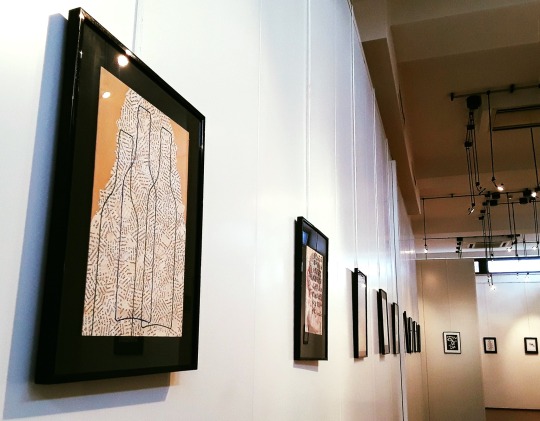
FUORIPAGINA Poesia Visiva dalla collezione Roffi a cura di Gian Paolo ROFFIInaugurazione sabato 26 settembre ore 17.00Dal 26 settembre al 25 ottobre 2020“Fuoripagina” fa un’altra tappa del suo già ricco percorso. Dopo l’inizio a Bettona (Perugia) e i passaggi allo Studio “Segni & Segni” di Bologna, al Mac,n di Monsummano Terme, al “Gabbiano” di La Spezia, alla Fondazione Balestra del Castello Malatestiano di Longiano, ora si presenta al MAGI ‘900 di Pieve di Cento.
Gli artisti in mostra sono:Vincenzo ACCAME, Fernando AGUIAR, Paolo ALBANI, Fernando ANDOLCETTI, Davide ARGNANI, Alain ARIAS-MISSON, Nanni BALESTRINI, Vittore BARONI, Gianfranco BARUCHELLO, Alessandro BENFENATI, Mirella BENTIVOGLIO, Carla BERTOLA, Joseph BEUYS, Tomaso BINGA, Julien BLAINE, Irma BLANK, Jean-François BORY, Anna BOSCHI, Antonino BOVE, José A. CACERES, Ugo CARREGA, Luciano CARUSO, Guglielmo Achille CAVELLINI, Sergio CENA, Giuseppe CHIARI, Henry CHOPIN, Cosimo CIMINO, Mario COMMONE, Vitaldo CONTE, Carlo Marcello CONTI, Corrado COSTA, Mauro DAL FIOR, Augusto DE CAMPOS, Haroldo DE CAMPOS, Paul DE VREE, Chiara DIAMANTINI, Marcello DIOTALLEVI, Pablo ECHAURREN, Alberto FAIETTI, Mariapia FANNA RONCORONI, Fernanda FEDI, Bartolomé FERRANDO, Gio FERRI, Luc FIERENS etc
https://www.magi900.com/fuoripagina-poesia-visiva-dalla-collezione-roffi/
4 notes
·
View notes
Photo

Galerie François I, Fontainebleau. Importante luogo della storia di Francia, il castello di Fontainebleau è stata una delle dimore dei sovrani francesi da Francesco I (che ne fece la sua dimora preferita) fino a Napoleone III
2 notes
·
View notes
Text
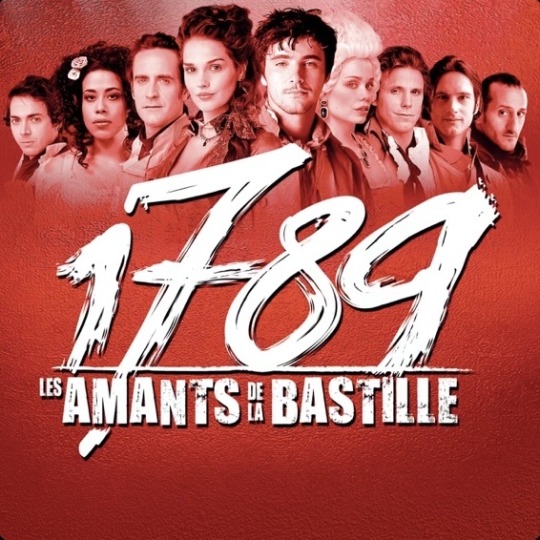
#musical theater#do you know this musical#poll#1789 les amants de la bastille#dove attia#françois chouquet#vincent baguian#rod janois#jean pierre pilot#olivier schultheis#william rousseau#françois castello#benoît poher#laurent delort#louis delort#silvio lisbonne#manon romiti#language: french
55 notes
·
View notes
Photo

✨Bright perspectives for difficult times - 📌The Battles Gallery in the Palace of the Royal Monastery of Escorial. Projected by Juan Herrera, he considered this big space as a private gallery for the King (this fact reminds me to a similar use in the François Ier Gallery in Fontainebleau). The fresco was made bu Niccolò Granello, Fabrizio Castello, Lazzaro Tavarone and Orazio Camiaso, and depicts some of the wars against the Islamic and French armies. 👆The whole gallery mesures 55 meters long, 6 meters wide, and 8 meters high. @patrimnacional (en Monasterio De San Lorenzo del Escorial, España) https://www.instagram.com/p/B9xJLB4I5p7/?igshid=1hax4phk9lmin
17 notes
·
View notes
Text




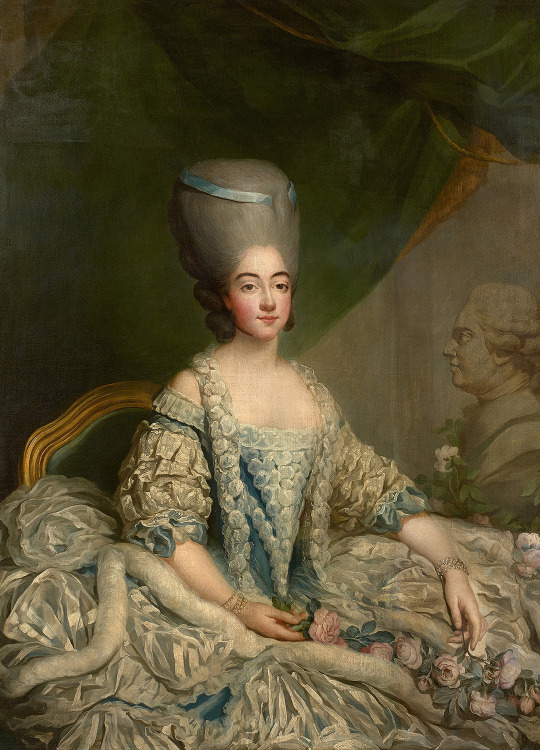
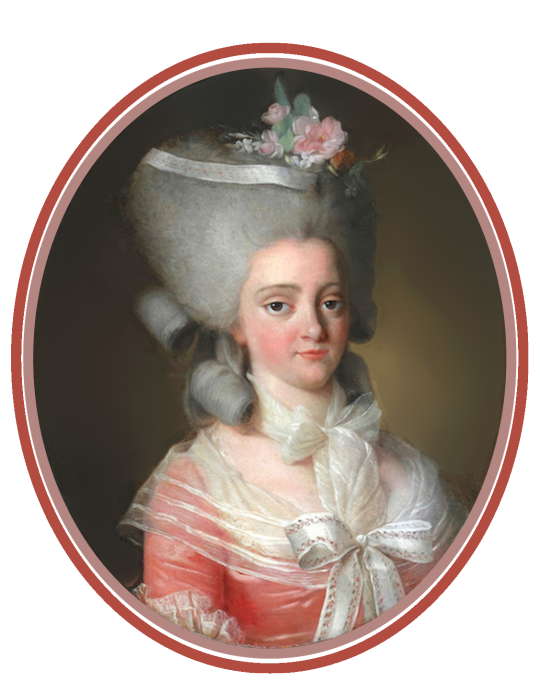
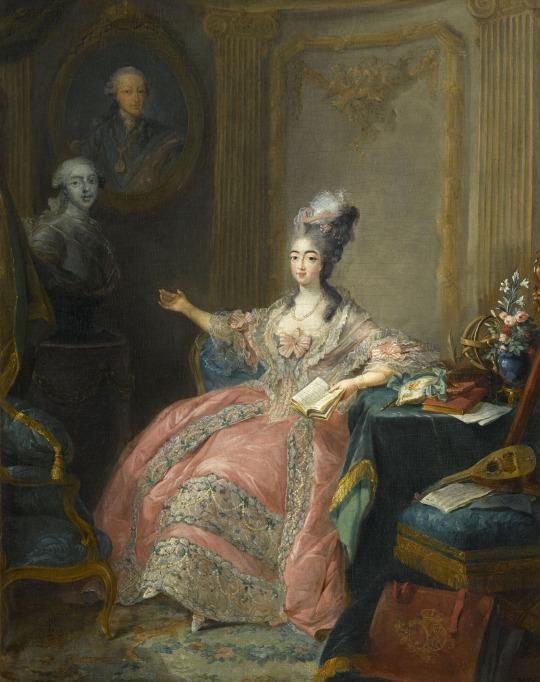
Marie-Josephine Louise de Savoie Comtesse de Provence:
Top left: 1768 (after)-1771 (before) Maria Giuseppina Luisa di Savoia by Domenico Duprà (Castello Reale di Racconigi - Racconigi, Cuneo, Piemonte, Italy). From catalogo.beniculturali.it/detail/HistoricOrArtisticProperty/0100399456 792X1012 @300 182kj.
Top right: 1772 Marie-Josephine Louise de Savoie Comtesse de Provence by Francois-Hubert Drouais (Versailles). From Magnolia Box; removed smudges and flaws with Photoshop 2463X3034 @150 1.1Mj.
Second row: 1771 Marie Joséphine Louise de Savoie, comtesse de Provence by François-Hubert Drouais (Palazzo Reale di Torino - Torino, Piemonte, Italy). From Wikimedia; removed spots and flaws with Photoshop 2265X2909 @72 2.1Mj.
Third row left: 1774 Marie Joséphine of Savoy, Countess of Provence by or after François Hubert Drouais (Metropolitan Museum of Art - New York City, New York, USA). From liveinternet.ru/users/3251944/post447054917/ 1011X1400 @72 865kj.
Third row right: Countess of Provence Marie-Joséphine de Savoie in front of a sculpture of Louis XVIII by Jean-Martial Frédou (location ?). From Wikimedia; removed more obvious spots and a tear with Photoshop 1080X1500 @96 950kj.
Fourth row left: Marie-Joséphine de Savoie, comtesse de Provence by ? (location ?). Posted to marie-antoinette.forumactif.org-t261p75-marie-josephine-de-savoie-comtesse-de-provence#97735 on 5 May 2017 by La nuit, la neige 1127X1423 @300 1.1Mj.
Fourth row right: 1777 Marie Joséphine of Savoy, Countess of Provence pointing to a bust of her husband overlooked by a portrait of her father by Jean-Baptiste André Gautier d'Agoty (Versailles). From Wikimedia 1600X2020 @144 4.9Mp.
#Maria Giuseppina Luisa di Savoia#Marie-Josephine Louise de Savoie#comtesse de Provence#Countess of Provence#Domenico Duprà#1760s fashion#Louis XV fashion#Rococo fashion#straight hair curled hair#hair flowers#hair jewelry#scoop neckline#off shoulder neckline#ruffled sleeves#elbow-length sleeves#full sleeves#Sévigné brooch#stomacher#V waistline#panniers#fur boa#1770s fashion#Francois-Hubert Drouais#high coiffure#bare shoulder robings#lace bertha#puffed cloth ornaments#hair bow#Jean-Martial Fr��dou#hair ribbon
13 notes
·
View notes
Text
LO SCORSO ANNO È ANDATA COSÌ…
Secondo il credo di François Truffaut, “Tre film al giorno, tre libri alla settimana, dei dischi di grande musica faranno la mia felicità fino alla fine dei miei giorni”, e come dargli torto? Tenendo conto che però i ritmi di Truffaut sono certamente inarrivabili, ne condivido di certo la filosofia. Quest’anno è andata così, però ho la pessima abitudine di non annotare i dischi che ascolto, ecco un buon proposito per il 2023.
ANNO 2022
"Tullio Pericoli: Frammenti", Palazzo Reale Milano, 02.01.22
“Il Mito di Venezia da Hayez alla Biennale” Castello di Novara, 09.01.22
“Tania Bruguera, la verità anche a scapito del mondo” Pac Milano, 15.01.22
“Ciò che si trova solo in Baudelaire” di Roberto Calasso, 12.01.22
“François Berthoud, Hyperillustrations”, Fondazione Sozzani, 22.01.22
“Annientare” di Miche Houellebecq, 23.01.22
"Ennio" di Giuseppe Tornatore, 02.02.22
“Grand Tour, sogno d’Italia da Venezia a Pompei”, Gallerie d’Italia Milano, 04.02.22
“Irreversible Entanglements”, Spazio Nova, Novara Jazz, 06.02.22
"Il capo perfetto" di Fernando Leo de Aranoa, 19.02.22
"Gabriele Boggio Ferraris Quartet" Taste of jazz, 24.02.22
"Chris Pitsiokos & Mulhouse Ensemble", Spazio Nova, 26.02.22
"Gabriele Boggio Ferraris Quartet". Opificio, 25.02.22
"A-Septic W/Vladimir Tarasov". Spazio Nova, 07.03.22
"Belfast" di Kenneth Branagh, 09.03.22
"Flee" di Jonas Poher Rasmussen, 13.03.22
“Chris Pitsiokos and Mulohouse Ensemble”, spazio Nova, 15.03.22
“Limes: la Russia cambia il mondo”, 20.03.22
Francesco Chiapperini: “On the Bare Rocks and Glaciers”, Taste of Jazz Opificio, 28.03.22
“Barry’s Trio”, spazio Nova, 03.04.22
“I Defunti” di Manu Larcenet e Daniel Casanave, 03.04.22
Gustave Flaubert: "Due racconti giovanili" a cura di Chiara Pasetti
Steve Mc.Queen: "Sunshine State", Pirelli Hangar Bicocca, 10.04.22
"Kris Ruhs: Heroes" Fondazione Sozzani, 16.04.22
"Steve Harries. Octopus" Fondazione Sozzani, 16.04.22
Anicka Yi: "Metaspore" Pirelli Hangar Bicocca, 19.04.22
"Bruce Weber wearing Kris Rhus Jewelry" Fondazione Sozzani, 16.04.22
"Tra due mondi" di Emmanuel Carrère, 16.04.22
"Concerto Passio 2022" Cappella Musicale del Duomo di Novara, 23.04.22
"Finale a sorpresa" di Mariano Cohn e Gastòn Duprat, 24.04.22
Elmgreen & Dragset: "Useless Bodies?", Fondazione Prada, 10.05.22
Haruki Murakami: "Gli assalti alle panetterie", 12.05.22
“Nostalgia” di Mario Martone, 29.05.22
“C’era una volta la DDR” di Anna Funder, 10.05.22
“Jazz Notes” di Giuseppe Cardoni, Opificio Novara Jazz 02.06.22
Daniele Cavallanti: “World of Music” di Daniele Cavallanrti Opificio Novara Jazz 02.06.22
“Stilnòva
Lisen Rylander Löve & Mirko Pedrotti + Biennoise, Nòva, 03.06.22
Lisen Rylander Löve “solo”, Mulino Vecchio di Bellinzago, 04.06.22
“Trio Korr”, Doneda, Grossi, Monico, Mezzomerico, 04.06.22
“Mynd”, Museo civico di Oleggio, 04.06.22
“We3” Barriera Albertina, 07.06.22
“Collocutor”: Church of Sound, Basilica di San Gaudenzio, 07.06.22
Tor Yttredal & Roberto Bonati, Museo Faraggiana, 08.06.22
Banda Filarmonica Oleggio e Roberto Mandarini, Broletto, 08.06.22
Shingai, Broletto, 09.06.22
Simone Alessandrini, “Storytellers” Mura rimane, 10.06.22
“L.U.M.E.” Lisbon Underground Musci Ensemble, Broletto, 10.06.22
Peter Evans “solo”, Basilica di San Gaudenzio 11.06.22
Alberto Braida “solo”, Casa Bossi, 11.06.22
Tom Arthurs & Giovanna Pessi, Giardino Palazzo Natta, 11.06.22
“ACRE” con Ermanno Baron e Peter Evans
Theon Cross, “Soundsystem Setup”, Broletto, 11.06.22
Kit Downes “solo”, Chiesa di San Giovanni Decollato, 12.06.22
“Erios Junior Orchestra”, Broletto, 12.06.22
Bruno Chevillon “solo”, Galleria Giannoni, 12.06.22
“Archipelagos” con Francesca Remigi, Parco dei Bambini, 12.06.22
“She’s Analog” Chiostro della Caninica, 12.06.22
“Orchestre Tout Puissant Marcel Duchamp”, Broletto, 12.06.22
“Artivismo” di Vincenzo Trione, 13.06.22
“Sotto gli occhi dell’Agnello” di Roberto Calasso, 20.06.22
“Album D’Annunzio” a cura di Annamaria Andreoli, 30.6.22
“Paris s’il vous plaît” di Eleonora Marangoni, 08.07.22
“Il costume femminile” di Georges Vigarello, 13.07.22
“Zero Gravity” di Woody Allen, 16.07.22
“La figlia unica” di Abraham B. Yehoshua, 19.07.22
“Non date a Cesare quel che è di Dio” di Claudio Balzaretti, 01.08.22
“Di notte, davanti alla parete con l’ombra degli alberi” di Peter Handke, 10.08.22
“Chris Ware” Centre Pompidou, 20.08.22
“Tatiana Trouvé, le grand atlas de la désorientation” Centre Pompidou 20.08.22
“Le reste est ombre: Pedro Costa, Rui Chafes, Paulo Nozolino” Centre Pompidou, 20.08.22
“Shirely Jaffesi, un américaine à Paris”. Centre Pompidou, 20.08.22
“Simon Hantaï: l’exposition du Centanaire”, Fondation Vuitton, 21.08.22
“La Couleurs en fugue”, Fondation Vuitton, 21.08.22
“Un seconde d’etérnité” Bourse de Commerce Paris, 21.08.22
“Allemagne/Anée 1920/Auguste Sander”, Centre Pompidou, 22.08.22
“Mirdidingkinghati Sally Gabory” Fondation Cartier Paris, 23.08.22
“Jean Painlevé: les pieds dans l’eau”, Jeu de Paume Paris, 23.08.22
“Les mondes Surrealiste de Elsa Schiaparelli” Musée des Arts Decoratifs Paris, 24.08.22
"Maison Dior", Parigi, 25.08.22
"Non date a Cesare quel che è di Dio" di Claudio Balzaretti, 31.08.22
"I miei giorni alla libreria Morisaki" di Satoshi Yagisawa, 05.09.22
"Il signore delle formiche" di Gianni Amelio, 11.09.22
"Un occidente prigioniero" di Milano Kundera, 20.09.22
"Chris Ware: la bande dessinée réinventée", 22.09.22
"Maigret" di Patrice Leconte, 23.09.22
"Remix the Cinema" Nu Arts and Community, 28.09.22
"Arsenal Ensmble: Nosferatu" Nu Arts and Community, 28.09.22
Gli instabili vaganti: "Lokdown Memory", Broletto Arts and Community, 29.09.22
"Elisabetta Consonni: Il secondo paradosso di Zenone", 29.09.22
"Sofia Donato, piano solo" Giardino Faraggiana Nu Arts and Community, 30.09.22
"Dove è più profondo"" Chiesa di Sant'Agostino, Nu Arts and Communite, 30.09.22
Ghenadie Rodani fisarmonica solo, canonica, Nu Arts and Community, 01.10.22
"As I was moving ahead occasionally I saw brief glimpses of beauty" di Jonas Mekas, Nu Arts and Community, 02.10.22
Joan Thiele, Nova, Arts and Community, 01.10.22
"Omar Soulyman" Nu Arts and community, 28.09.22
Ivan Ronda, organo. Festival di musica sacra. Basilica di San Gaudenzio, 09.10.22
"Unknown Unknows" Triennale di Milano, 15.10.22
"Il corridoio rosso" AA.VV., Catalogo mostra Triennale di Milano, 17.10.22
"Unknown Unknows" catalogo mostra Triennale di Milano, 20.10.22
"L'occasione fa il ladro" di Gioacchino Rossini, Teatro Coccia, 29.10.22
"La stranezza" di Roberto Andò, 30.10.22
"Il crogiolo" di Arthur Miller, regia di Filippo Dini, Teatro Strehler, 4.11.22
"Swinging Stravinsky" di Biagio Bagini, 7.11.22
"Ardenza" di Daniela de felice, 9.11.22
Anna Bassy, Nova, Nj Weekender Fall Editions, 12.11.22
Andrea Passenger, dj set, Nj Weekender Fall Editions, 12.11.22
Rosa Brunelo (e Tamara Osborne Collocato" Nòva Nj Weekender Fall Editions, 12.11.22
Dayakoda in solo, Nçva, Nj Weekender Fall Editions, 12.11.22
Jeff Parker solo, Nçva Nj Weekender Fall Editions, 13.11.22
Nicola Conte, Dj Set, Nçva, Nj Weekender Fall Editions, 13.11.22
Kahlil 'El Zara Quartet, Nova, Nj Weekender Fall Editions, 13.11.22
"Eros e Thanatos" Ilia Kim, piano. Conservatorio Cantelli-Amici della Musica, 14.11.22
"Tutta un'esistenza" Ivana Francisci, piano e Susanna Rigacci soprano, Conservatorio Cantelli-Amici della Musica, 22.11.22
"Lo stato delle cose" di Chiara Alessi", 23.11.22
“Recycling Beauty”, Fondazione Prada Milano, 03.12.22
Il fotografo Léon Herschritt, 09.12.22
“La Russia di Putin” di Anna Politkovskaja, 11.12.22
“Le otto montagne” di Felix Van Groeningen e Charlotte Vandermeersch, 26.12.22
“Bosch, un altro Rinascimento”, Palazzo Reale Milano, 30.12.22
“The Fabelmans” di Steven Spielberg, 31.12.22
4 notes
·
View notes
Text
WiMu
Chi mi conosce sa che sono astemia e quindi si starà domandando cosa ci faccio al WiMu, il Museo del Vino :-) Innanzitutto la cultura è sempre cultura anche se alcolica, il museo è innovativo e poi nel periodo autunnale i vigneti si tingono di colori fantastici. Se anche voi concordate che queste sono motivazioni più che valide per visitarlo, proseguite la lettura.

Il WiMu è un museo del vino che si trova nel Castello Falletti a Barolo (Cuneo), tra i famosi vigneti delle Langhe. E’ innovativo perchè non ha lo scopo di spiegare le diverse fasi della produzione come di solito accade in questo tipo di musei ma si concentra sugli aspetti culturali narrando il rapporto tra l’uomo e questa preziosa bevanda.

Inoltre, la narrazione è un viaggio emozionale ed interattivo (ed io amo particolarmente questi percorsi) ideato da François Confino, uno fra i più apprezzati specialisti al mondo in allestimenti museali.

Il piano nobile del castello celebra invece la storia dei marchesi Falletti, figure fondamentali nella creazione del vino barolo, e dei loro prestigiosi ospiti tra i quali Silvio Pellico che qui fu bibliotecario e del quale è possibile vedere la camera-studio.


La marchesa Giulia era particolarmente dedita alla filantropia a favore delle persone più deboli e tra le sue attività vi è anche la trasformazione del castello in Collegio Barolo; infatti, nel seminterrato è stata ricostruita un’aula dove vi attende un maestro virtuale.
Non perdetevi poi il panorama visibile dalla terrazza: un tripudio di colori nel periodo autunnale!


1 note
·
View note
Text
Only a day or two ago I was notified that I was in contact with some people tested for and found positive for Covid-19, this came as nothing un expected, I was in contact with hundreds of people many from Europe recently. Then, as you know we are experiencing, most Universities, Libraries and Book Shows have been indefinitely closed, and because of this; many of us find or try lively-hood’s challenged. In a situation where it seems that there is little to do that will improve the current situation any faster than time will take its course, I have turned to reading and writing. I have been researching, as best as I can from home, fifteen books which are new to my stock. There are many more stuck in Europe and this gives me hope. It is the first day of spring and I awoke to a beautiful snow squall… In like a Lion..
And here are the fruits…
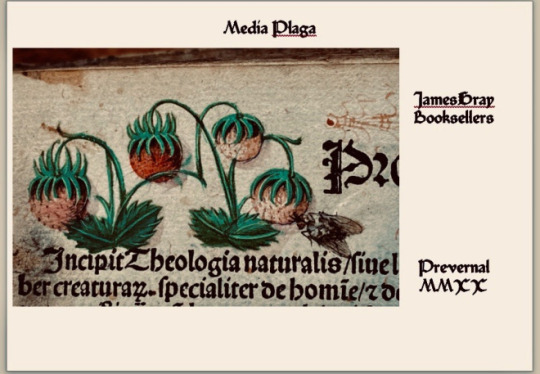
1). 355J Bible Saint Jerome, Gabriello Bruno (active 1480-1514.)
Biblia cum summariis concordantiis : diuisionibus: quattuor repertoriis p[ro]positis: numeriq[ue] foliorum distinctione: terse et fidelit[er] imp[re]ssa. { With table of Gabriel Brunus }
[Lyons]: Jean Pivard, 29 Jan. 1500 & 1. $ 15,000.
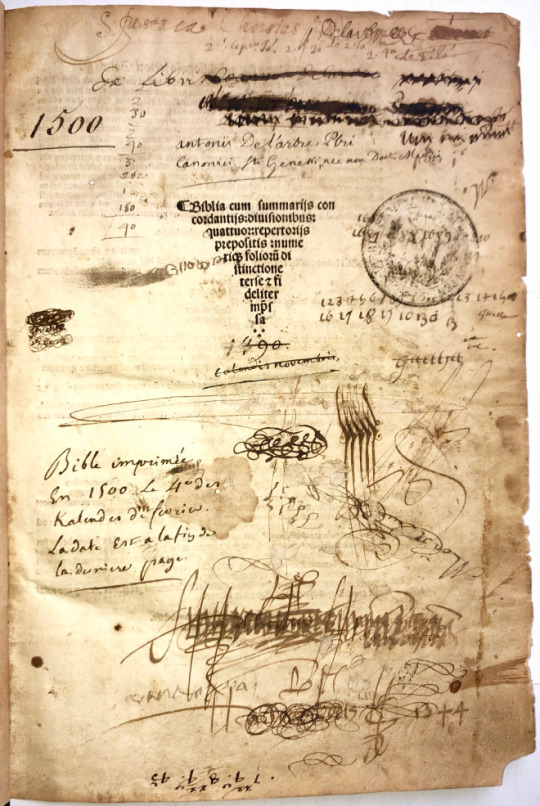
Impresserunt aute[m] solertes viri Franciscus Fradin et Ioha[n]nes Piuard socij impressores. …,]
Folio inches, &8 ç8 , a8 b6, c-z8 A-Z8 Aa8 Bb8; aa-cc8 dd10. Bound in original full calf over wooden boards with 10 brass bosses.
This edition corresponds with the edition printed by Fradin and Pivard in 1497. There are the same tables, summaries, &c.; and the arrangement of the books and the readings are alike. At the end of the subscription we read: “Impressit autem solers ori Johänes Pivard impressor. Deo sint sempiterne gratie.”
Pivard,who was working alone from 7 March 1498 to 1501, Started printing with François Fradin in 1497 (Goff B602) ISTC lists15 titles solely printed by Privard.
Goff B604; HC 3128; GfT 1883, 1884; Pell 2341; CIBN B-426; Arnoult 288; Girard 108; Parguez 213; Polain(B) 4210; IBE 1040; SI 764; Martín Abad B-134; Sallander 2098; Bod-inc B-312; Sheppard 6736; Pr 8670; GW 4281. (Gutenberg-Jahrbuch 1965 p140-3)
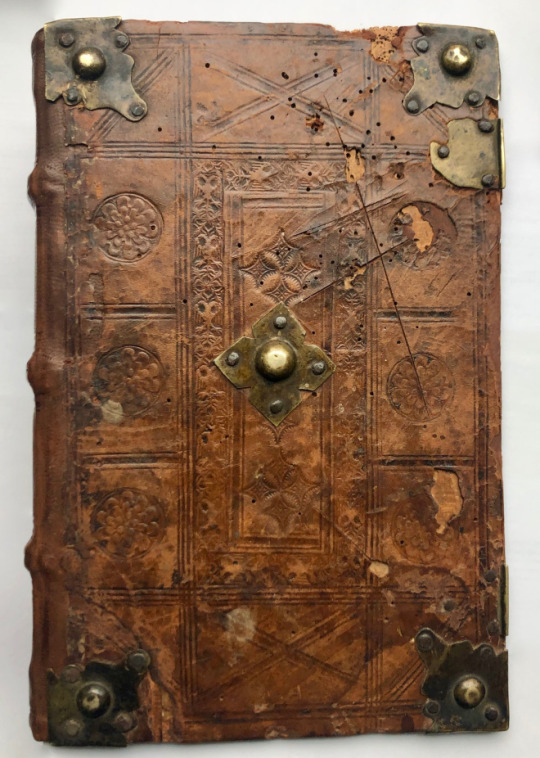
Copinger, Incunabula Biblica, 120; Darlow–Moule 6090; Sheppard 6736.
U.S. copies: Boston Public Library, General Theological Seminary, Jewish Theological Seminary of America, Library of Congress, Rare Book Division, Southern Methodist Univ., Bridwell Library (418 ff)
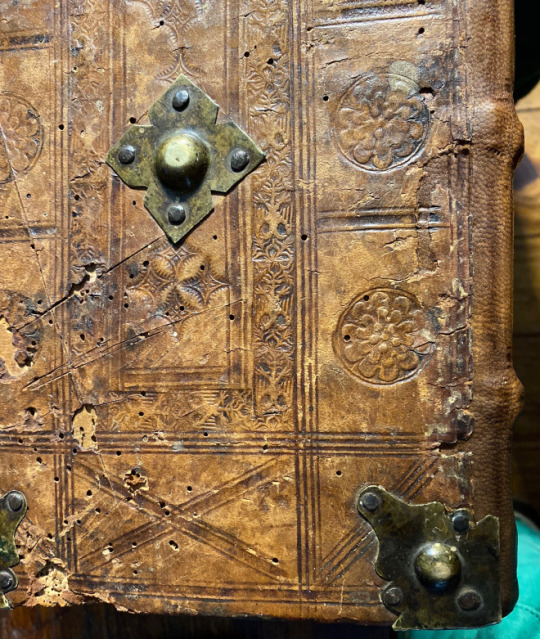
https://data.cerl.org/istc/ib00604000
◊
◊ ◊
◊
2) 353J Alberto da Castello (ca. 1460-1522)
Rosario della gloriosa Vergine Maria : con lle sttattiionii & iindullgenttiie delllle chiiese di Roma perr tutto L’’anno.
In Venetia : Presso la compagnia de gli Vniti,1585. $7,800

Octavo. 6 x 3 3/4. A-Z, Aa-Ii8. A later edition of the first ‘Rosary Book” in Italian.
This book has a wonderful contemporary binding, recently expertly rebacked. It is of red Morocco with gilt center images and borders gilt, with angels. Certainly these books were
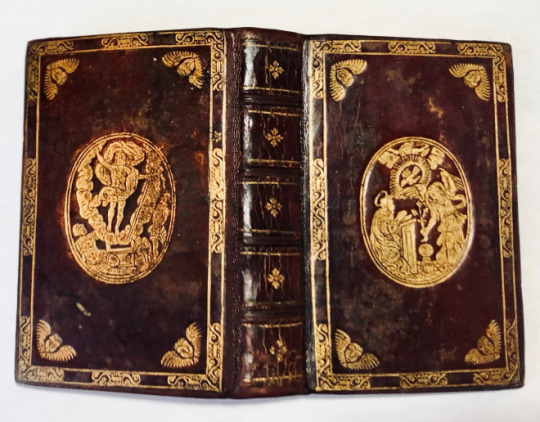
very popular, that said, very few copies have survived. This edition is represented on OCLC by only two copies worldwide. 1 US copy Saint Benedict/Saint John’s University. (SJU Alcuin Arca Artium Rare BookBX2163 .C37 1585). [The authorship of the work and the woodcuts are attributable to the Dominican Friar Alberto da Castello, identified as author or editor at the authorizations of the Venecian Inquisition, given 5 April 1521. (Francesco Pisano)]
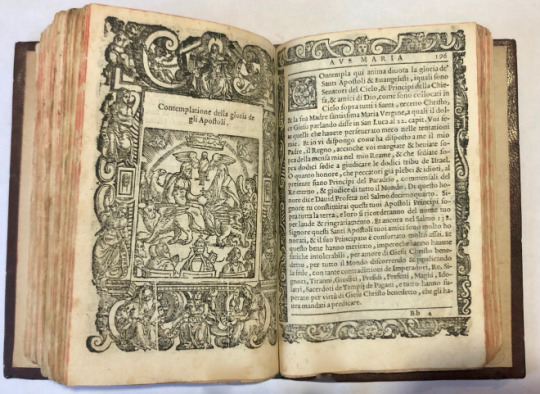
Over 150 woodcuts (including repeats) comprising almost full-page cuts (1 on t.p.) within borders. All had previously appeared in earlier editions. Ornamental and pictorial border pieces on almost every leaf. ( The wood cut on leaf 173v is upside down in the border!) Each wood cuts represent the “Mysteries of the Rosary”
“From the beginning, publications on the Rosary came accompanied by lavish xilographic illustrations. The most striking of these can be found in the edition of the Rosario della gloriosa Vergine Maria by Alberto da Castello from 1521 [Fig. 14.1], which contains a wealth of illustrations. This clearly shows that the Rosary was not just an oral recitation, but was also a contemplative prayer engaging the imagination, a combination later mirrored by the exercises of Ignatius of Loyola.
Alberto da Castello, born in the middle of the fifteenth century in Venice, joined the Dominican order around 1470 and wrote several devotional, liturgical, historical and canonical texts. In the Epistola prohemiale of his Rosario della gloriosa Vergine Maria he says that he wrote the meditations and organised the images ‘acciò che gli idioti che non sanno legere habbino el modo de contemplare gli divini beneficii et de questa contemplatione ne habbino qualche frutto spirituale’.( fol. 6r. ‘So that even the illiterate have a means to contemplate gifts of the divine and to receive spiritual fruits from such contemplation’ (translations are mine).He states that he writes especially for the ‘ignoranti, illetterati, idioti’, and that a good Christian must hold the mysteries of the Rosary deep in his heart. (Literary and Visual Forms of a Domestic Devotion: The Rosary in Renaissance Italy. Erminia Ardissino)

The mysteries of the rosary were introduced by Dominic of Prussia sometime between 1410 and 1439. This gave each decade of the rosary a unique quality. Each mystery leads us to ponder very specific events in the lives of Jesus and Mary and the lessons they hold for our own lives today.
The Rosary has a ritual aspect that individual prayers lack, and it is highly structured. It entails the recitation of 150 Ave Marias, clustered in groups of ten, preceded by a Pater noster and the proposition of a ‘mystery’ upon which to meditate. This number of 150
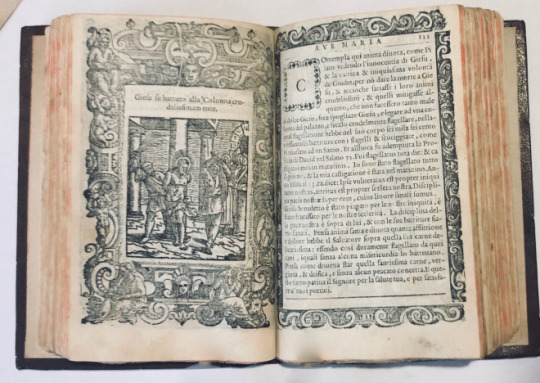
Ave Marias seems to be designed to correspond to the 150 psalms in the Davidic psalter, which is why the Rosary is also known as the ‘Virgin’s psalter’. It does not consist only of repetitive prayers, however, but also entails meditations. Indeed, the Rosary created by Dominic of Prussia was a kind of meditation on the life of Christ and Mary. In his Liber experientiarum he ‘explicitly claimed to be the first to have composed a series of fifty points on the life of Christ that were to be meditated on while reciting the Ave Marias’.
Sander 6572-6573. See: Essling 2124
)0(
100 full page plates and a volvelle!
3) 382J Jan David. 1545?-1613.
Veridicus christianus: auctore P. Joanne David … Editio altera, auctior.
Antverpiæ ex officina Plantiniana, M. DCVI. $6,500
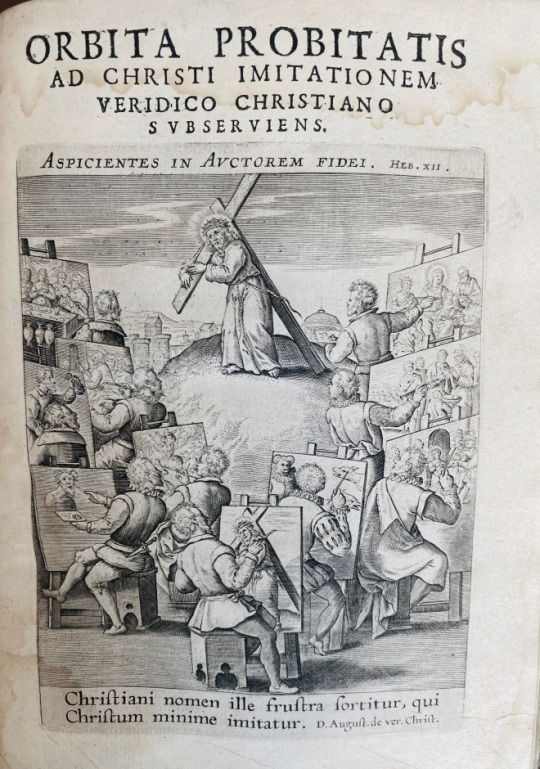
Quarto 8 1/2 X 6 inches ‡4, ‡‡4, A-Z4, a-z4, Aa-Ee4.+ 100 Numbered Plates. Withspecial engraved t.p. with allegorical depiction of Christ carrying the cross, surrounded by ten artists at easels painting scenes from his life (as well as a few questionable profane subjects).
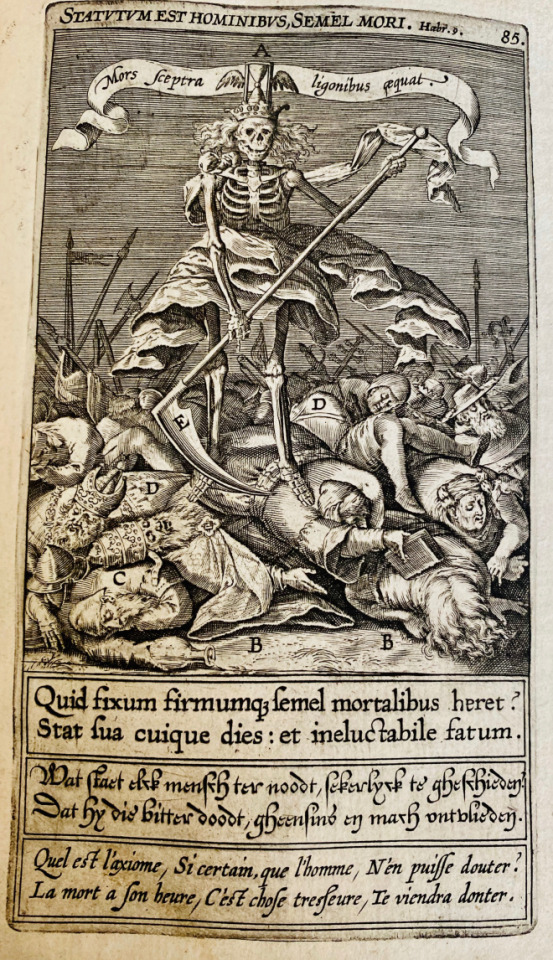
The text is divided into 100 chapters, each with an allegorical engraving incorporating letters keyed to the explanatory text and with marginal references. Each of the 100 numbered plates has a single line of Latin at the head giving the subject, with two-line explanatory verses below the allegorical engraving in Latin (roman letter), Dutch (civilité) and French (italic) First plate (following [2 daggers]4) is added title leaf for the ill., which were also published separately; see Bibliotheca Belgica. The added title reads: Icones ad Veridicvm Christianvm P. Ioannis David e Societate Iesv At the end is Device with compasses and the motto “constantia et labore” on Ee4r . This book is notoriously found defective in one way or another, this copy is perfect and complete.
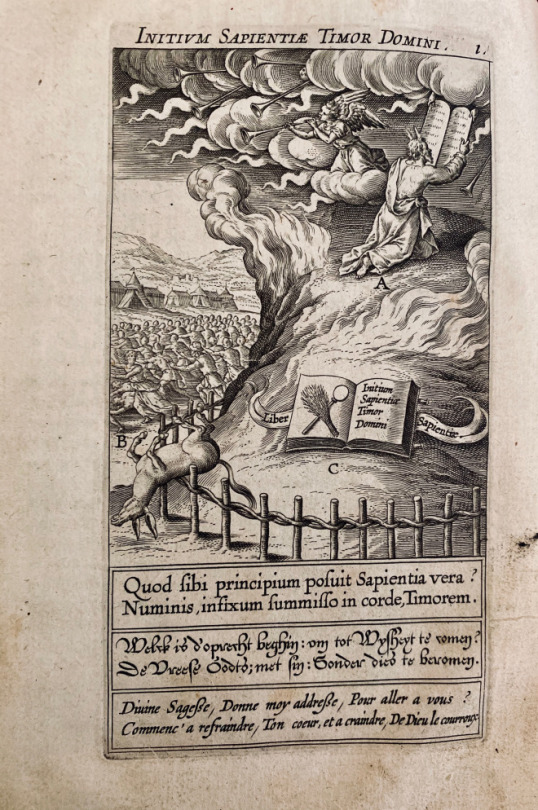
This copy is bound in full contemporary blind stamped calf over wooden boards with two working clasps.
The Veridicus christianus: is followed by the “Orbita probitatis ad Christi imitationem veridico Christano subserviens”: p. 351-374; which preceds a volvelle plate for use in locating specific passages.

This text contains a series of images with accessible (sometimes to a fault) moral or religious messages. These illustration swarns against opening the senses to temptation lest death and moral decay take up residence in one’s soul.
The Veridicus Christianus emphasizes the Society of Jesus’ investment in thinking in, though, and about visual images that exemplify the supreme mystery of God. Published as a tool of devotion and meditations, it features one hundred chapters that encompass a wide range of topics for reflection. Each chapter incorporates an extensive commentary that interprets the emblematic image David too follows the order in which we apprehend things with our senses, beginning with a visual representation at the head of each chapter. Then comes the explication. The symboli explicatio was considered necessary because cultivated readers would be more susceptible to a reasoned argument than a picture.
Here are images of the vovell. The centers of the engraving and the volvelle (through which a string passes) are reinforced with small paper roundels printed with the monograms of Christ. The numbers are keyed to an “Indiculus orbitae” that follows (Bb1r-Bb2r). There a number, having been selected, is provided with a phrase from various Latin authors (listed on Bb2v), and a reference to one of the hundred sections that comprise the main text. It is suggested in Bibliotheca Belgica that this game may have been intended as a pious alternative to such superstitious books as Thuys der fortvnen.
)0(
4) 312J. Domenico Cavalca. (1270?-1342)
Pungi lingua
[Baptista de Tortis]: Venexia, Adi .viiii. de Octubrio. 1494 $12,000
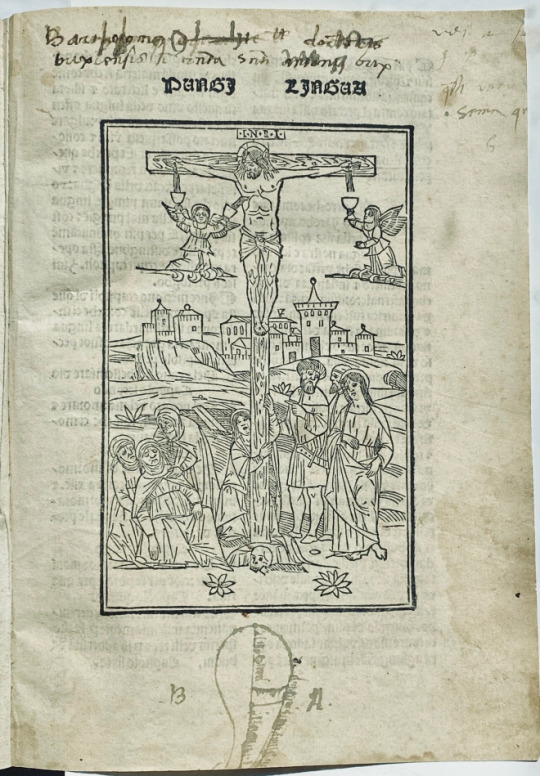
Quarto (200 x 145 mm); [80] pages. a-k8. Large woodcut depicting the crucifixion on the frontispiece, First Venetian edition with the beautiful woodblock published here for the first time. This copy has a beautiful initial “A” in gold, blue, red and green, a colorful coat of arms. This copy is bound in modern carta rustic with a gold title on an orange label

This is a treatise on the dangers of the misuse of the language it was, as you might expect quite popular . Written by the Dominican monk who was a contemporary of Dante and among the first to write in the vernacular, and one of the most successful translators of holy texts.
Aside from Biblical illustrations, the Pungilingua has many exempla drawn from many other sources including some not includes in the Alphabetum narratinum. Most of the stories are told in one to three lines, and many contain commerce with the Devil, one time disguised as a horse. In the prologue Cavalca mentions that he gathered his exempla from many sources “alcune poche cose” . One of the major sources is the Summa Vitiorum by Peraldus. but he also quite a few profane authors , Seneca, Socrates, Cicero, Valerius Maximus. That said, quite often Cavalca attributes the wrong author. Cavalca writes as though he was speaking to the reader in person useing phrases like “Io per me credo” and “Oimé “ Introducing unique stories and words, He refers to someone as double-tongued as a “tecomeco” (bilingue) . He refers to a sleight of hand trick ,called “gherminella” a word which was used later by Boccaccio. This is an important book in Italian literary history, and the Italian vocabulary leaving many contemporary proverbs and descriptions of medieval life. Goff C342; H(Add)C 4776a; R 116; Pell 3448; CIBN C-195; IGI 2637; Essling 750; Sander 1853; Pr 4649; BMC V 328; GW 6413
One copy in Goff. Huntington Library.
Queried Location: New York NY, Manhattan College: sold Christie’s (NY) 1 June 1991 lot 41 (current whereabouts unknown)

***
***
5) 350J. Richard FitzRalph (Ricardus Radulphus Armacanus pseudonym) (circa 1300-1360)
Summa Domini Armacani in Questionibus Armenorum noviter impressa et Correcta a magistro nostro Johanne Sudoris. Cum aliquibus Sermonibus eiusdem de Christi dominio.
Paris: Jehan Petit et ponset le Preux, (Venales habentur in vico divi Jacobi sub Lilio aureo) 1512. [Privilège octroyé à Jean Petit et Poncet Le Preux daté du 12 mars 1511 (1512 n. st.) et prenant effet le 15 juillet 1512.]. $24,000
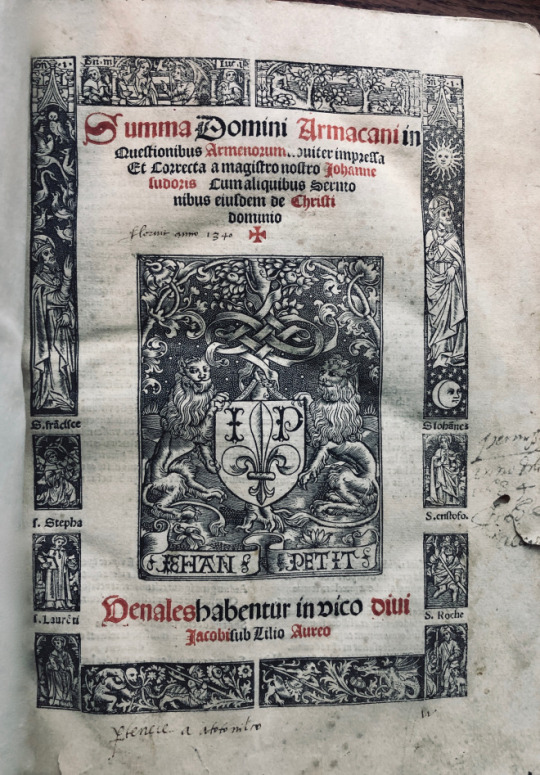
Small Folio 275 x 201 mm. A6 a-z6 &6 A-E6 F4. [6], 177 [i. e., 178] leaves. This copy is bound in a Remboîtage of later limp vellum; contents toned and brittle, lightly damp wrinkled with marginal damp staining at beginning and end, contemporary inscriptions on title and scattered underscoring and marginalia, wormhole through blank outer margin of approximately the first 30 leaves, paper crack in o1 not affecting text, last leaf reinforced in outer margin on verso. A Mexican Augustinian branded ownership mark on bottom edge. This is the only printed edition of the Summa in Questionibus Armenorum which is an examination of alleged Armenian doctrinal errors, the chief dogmatic work by an Irish theologian and prelate involved in negotiations between the papal court at Avignon and Armenian representatives over the reconciliation of the Roman and Armenian churches. FitzRalph, whose Defensorium curatorum was first published circa 1483, was one of the earliest Irish authors to appear in print. Renouard-Moreau II, 314; Shaaber M119; not in RBH or ABPC. Moreau, B. Inventaire 1512- 314; Index des livres interdits, t. IX, p. 86 (n° 50/499; Page de titre en rouge et noir dans un encadrement de plaques gravées sur métal, marque de Jean Petit (Renouard, 890) Adams, F-550
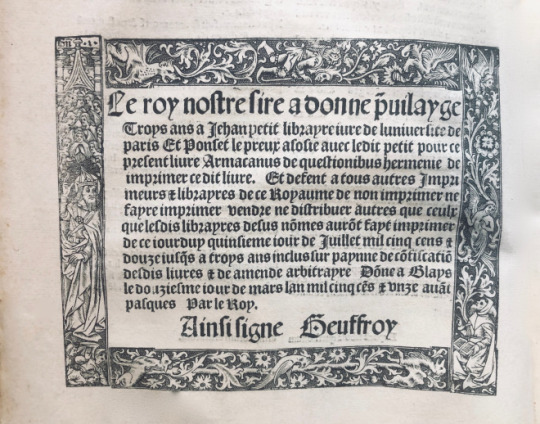
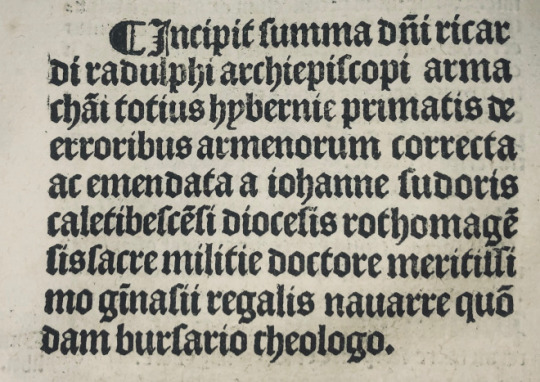
><><><><><
6) 358J Jacobus de Gruytrode 1400-1475
Speculum animae peccatricis
[Memmingen : Albrecht Kunne, about 1490] $6,500

Quarto , [28] ff, 33 lines, the first initial (5 lines) is painted in white and blue on a golden background, upper and left margin richly decorated in red, purple, blue and gold and with two red beasts. 19th c. binding in half leather, title gilt on spine, all edges gilt. Sometimes falsely attributed to Dionysius Carthusiensis, the Speculum is now attributed either to Jacobus de Gruytrode (cf. Bloomfield) or to Jacobus de Clusa (cf. L. Meier, Die Werke des Erfurter Karthäusers Jakob von Jüterbog, Münster, 1955).

Speculum animae peccatricis is a work of spiritual edification which consists of seven sections: on human misery, sin (especially lechery), penance, rejection of the world, the vanity of human wishes, death and hell and heaven.
Firste of the filthenes and miserie of man. Below are the chapter in English
Secounde of the synnes ingeneralle and of their effectis.
Thyrde howe they ought hastely with all diligence to do penaunce.
Fourth howe they ought to fle the world.
Fyfthe of the false Riches and vayne ho∣noures of the worlde.
Sixt howe they ought to drede deth.
Seuenth of the Ioyes of paradyse and of the paynes of hell.
There is no modern critical edition of the text. Among the devotional books by the Flemish mystical writers of the fourteenth and fifteenth centuries, none was more popular on the Continent and in England during the early Renaissance than the Speculum aureum animae peccatricis or The mirroure of golde for the synfull soule, which Lady Margaret Beaufort translated into English. Since the sixteenth century, bibliographers have listed the Speculum as the work of the Carthusian monk Jacobus de Gruytroede, prior of the Liége Charterhouse from 1440 to 1475, yet the English version is always attributed to his friend Denis de Leuwis or Dionysius the Carthusian, as he is better known. The question of authorship may be satisfactorily settled as the result of recent research by an English Carthusian scholar in the library of the Certosa in Farneta. He noted that the editors of Dionysius’s Opera omnia (Tournai, 1913) explain how the error in authorship began. In volume xlii they point out that, owing to the Carthusian tradition of anonymity during a monk’s lifetime, the Speculum was printed anonymously until 1495, in which year the Nuremberg printer Paul Wagner first issued it as a work by Dionysius. He found the manuscript of the Speculum in the library at Ruremond, where Dionysius was prior until his death in 1471, and supposed it was written by him, as were the other works he intended to print. The two priors were close friends, and dedicated several of their works to each other. Nugent E.M. (1969) Jacobus de Gruytroede. In: Nugent E.M. (eds) The Thought & Culture of the English Renaissance. Springer, Dordrecht
Goff S644; HC 14899*; Pell 4313; CIBN S-333; IGI 5001; IDL 2532; Schlechter-Ries 1003; Voull(B) 1617,5; Schmitt I 1614,2; Hubay(Augsburg) 1141; Hubay(Eichstätt) 538; Sack(Freiburg) 1951; Walsh 988; Bod-inc S-258; Sheppard 2032; Pr 2804; BMC II 608; BSB-Ink I-23; GW M10734
U.S. copies;Harvard ,Emory, Columbia ,Huntington Library
Southern Methodist Univ, Univ. of Illinois at Urbana-Champaign Library
)0(
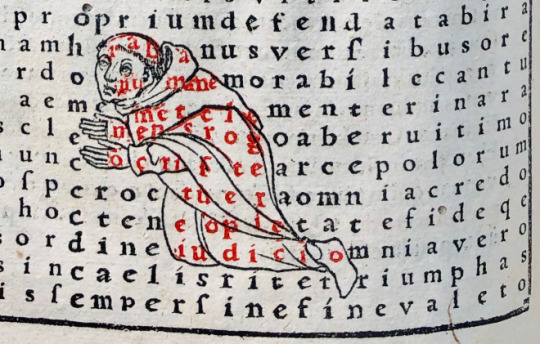
Nam digiti scripto laetantur, lumina visu Mens volvet sensu mystica verba Dei
“The fingers rejoice in writing, the eyes in seeing, and the mind at examining the meaning of God’s mystical words.”
The first printed facsimile of a manuscript.
7) 351J. Hrabanus Maurus. 784-856?
Magnencij Rabani Mauri De Laudib[us] sancte Crucis opus. erudicione versu prosaq[ue] mirificum.
Phorçheim. [Pforzheim] : In ædibus Thom[ae] Anshelmi., 1503. $10,700
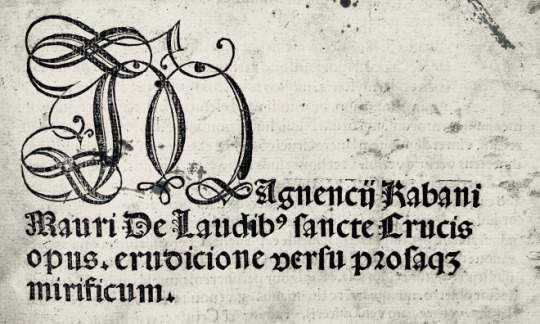
Folio Aa6, Bb4, a-k6, A-B6, C4 (last leaf blank).
THIS COPY LACKING [four leaves] A5 & 6, Bb1 and a1. [two woodcuts of Alcuin interceding on behalf of Rabanus before Pope Gregory iv, and of Rabanus presenting his poems to the Pope; and two figured dedicatory poems the first to Louis the Pious the next christ crucified] It is bound in a full vellum modern binding. First Edition (for a second edition see below) Types 3:109R, 4:180G; 40 lines of transcribed verse + headline, 40 lines of commentary + headline, red and black printing throughout, calligraphic woodcut initial (Proctor, fig. 24) M on title page, woodcut initials printed in red, and a figured prefatory poem, 28 carmina figurata, the first entirely xylographic, the remaining poems combining printed and xylographic letters with the versus intexti printed in red (except fig. xvi), enclosed by either woodcut figures (of the emperor, Christ, the Evangelists, Cherubim, etc.) printed in black or by Christian symbols and characters, most defined by metal rules in red.
This is a remarkable typographical achievement, probably the earliest attempt to reproduce a medieval manuscript. The greater portion of the work comprises a preface in verse and twenty-eight poems. “Hrabanus Maurus, the abbot of Fulda, wrote in the midst of the ‘new monasticism,’ a period associated with a revival of literacy and learning. In religious and secular spheres. This ‘script culture,’ as Rosamond McKitterick has it, used the written word not only as a mode of communication but as ‘a resource, a guide, a key, and an inspiration,’ especially in the devotional practice of Christianity.
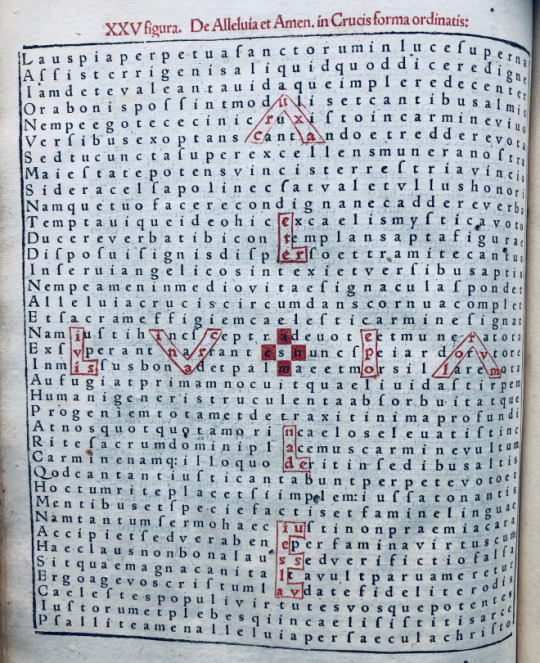
Each of the twenty-eight picture poems that form In honorem sanctae crucis explores a different theme relating to the Cross through a complex interplay of word and image. The poems each have an equal number of letters per line, written continuously like a grid. By following the letters in the usual direction for a Latin text—from left to right, top to bottom—each grid reads as one long poem. But within each grid, certain letters are also marked out with colour and drawings to form pictures. The letters that make up these pictures read as separate short poems embedded within the larger poem. As such, each page of In honorem sanctae crucis presents not just a puzzle of words and pictures, full of hidden and interrelated messages for the reader to decode bout a meditation exercise.
“Hrabanus created the various shapes and figures by highlighting individual letters in underlying poens in colour (in the printed editions red), and theses individual letters together make up meaningful text , ranging from simple declarations to very elaborate ones. For example, Carmina 2 contains a simple cross inside a square (Hrabanus calls it a “tetragonum”)whose sides form a border for the poem as a whole. The textfrom the underlying poen that makes up the figure consists of six hexameters, each one an address to the cross beginning with the words ‘O crux…’ When we follow Hrabanus’s instruction in the accompanying prose text for reading these hexameters, we find the following: even though the verse that forms the top of the square is also the opening of the underlying poem, he insists that we begin reading with the stem of the cross, from top to bottom.” (Schipper)
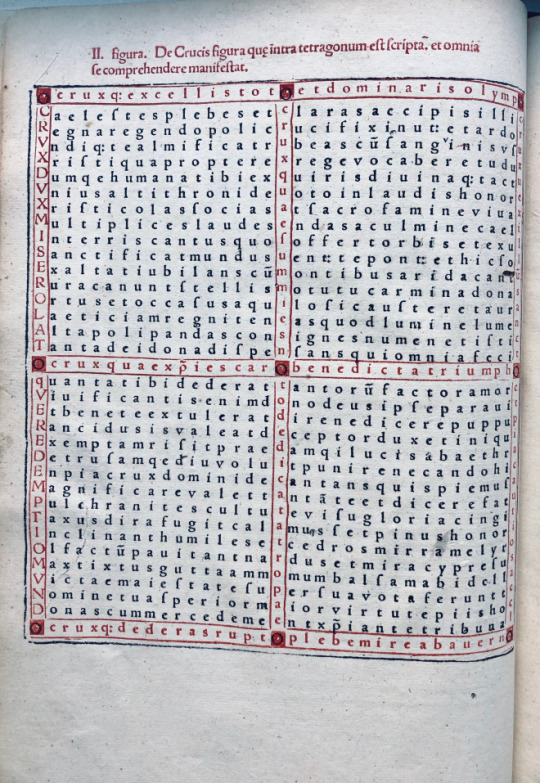
Sunt quoque uersus duo in ipsa ccruceconscripti, quorum prior est: O CRVX QVAE SVMMI ES NOTO DEDICATA TROPAEO
a summo in ima descendens. Alter uero: O CRVX QVAE CHRISTI ES CARO BENEDICTA TRIVMPHO a dextra in sinistram crucis tendens ‡
‡“there are also two verses inscribed in the cross, the first of which is : “ O cross , thou who art at the height of fame, a dedicated moment” ‘running from the top down. And a second’ “O Cross thou who through the body of Christ art the blessed triumph” ‘running from the right to the left.’
Further more Hrabanus flips left and right the texts point of view alternates , Hrabanus tells us the cross is looking out at the reader, not the other way around. “ Only after we have read the hexameters in the cross are we free to read the verses in the four sides of the tetragon, and even then Hrabanus constrains the order in which they are to be read: first the top, then the bottom, then the right side then finally the left side.”
More complex figures present further challenges in reading. The figure in Carmen 25, for example, consists of eight letters of the word ‘ALLEVIA’ arranged around a small cross. It does not take much effort to notice that we need to start with the A, read down to the E, continue on the left, and end on the right of the figure; and that each time we trace out those letters we make the sign of the cross. It becomes more difficult when we also try and read the text that is enclosed in the figures.

The letters of ALLEVIA are made of the following letters from the underlying poem. A crux[a L eter L na[de E i]es[lave[v L ivis V in]arc I e]po A lorvm
CRUX AETERNA DEI ES LAVS VIVIS IN ARCE POLORUM
‡ Eternal cross, thou art the praise of God, thou livest in the arc of the skies.
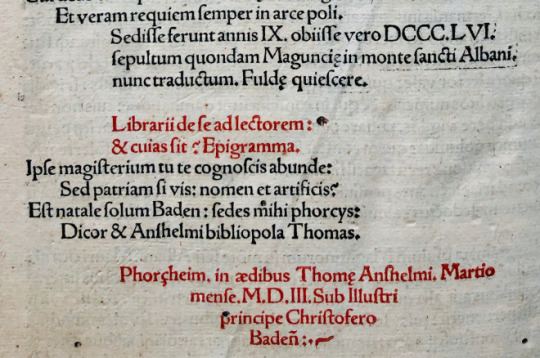
Peter Godman, Poetry of the Carolingian Renaissance (Norman: University of Oklahoma Press, 1985), 249. A. G. Rigg and G. R. Wieland, ‘A Canterbury Classbook of the Mid-eleventh Century Anglo-Saxon England 4 (1974), 113-30.
William Schipper, ‘Hrabanus Maurus in Anglo-Saxon England: In Honorem Sanctae Crucis’, in Early Medieval Studies in Memory of Patrick Wormald, ed. Stephen Baxter, Catherine Karkov, Janet L. Nelson, David Pelteret (Farnham, Surrey; Burlington, Vt.: Ashgate 2009), 283-98.
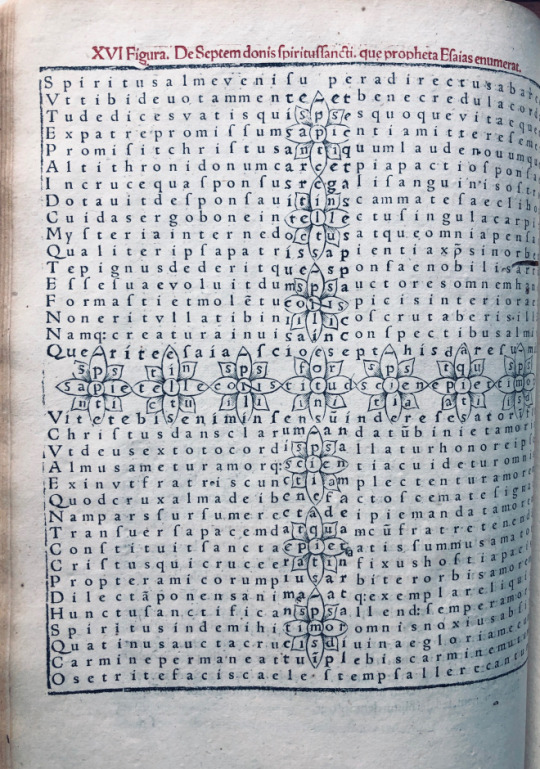
Proctor, R. Index to the early printed books in the British Museum,; 11747; Adams, H.M. Catalogue of books printed on the continent of Europe, 1501-1600, in Cambridge libraries,; R3; Catalogue of a collection of early German books in the library of C. Fairfax Murray,; 350; Panzer, G.W.F. Annales typographici,; VIII 227, 2; Pollard, A.W. Catalogue of books mostly from the presses of the first printers … collected by Rush C. Hawkins,; 189 Panzer, VIII, 227, no. 2. Proctor 11747. Fairfax Murray 350./ Last leaf blank./ Edited by Jakob Wimpheling.–cf. title page verso./ Illustrations: 2 woodcuts of the author presenting his book to the pope, and many woodcut figures (Christ, cherubs, crosses, symbols, etc.) printed on 28 pages of text. Some of the text within and near the outline figures is xylographic, the rest printed. The letters within the outlines are printed in red and may be read separately in a different sense. Printed in red and black, initials (except on t.p.) in red./ With label of Sinclair Hamilton. Peter Godman, Poetry of the Carolingian Renaissance (Norman: University of Oklahoma Press, 1985), 249. A. G. Rigg and G. R. Wieland, ‘A Canterbury Classbook of the Mid-eleventh Century Anglo-Saxon England 4 (1974), 113-30. William Schipper, ‘Hrabanus Maurus in Anglo-Saxon England: In Honorem Sanctae Crucis’, in Early Medieval Studies in Memory of Patrick Wormald, ed. Stephen Baxter, Catherine Karkov, Janet L. Nelson, David Pelteret (Farnham, Surrey; Burlington, Vt.: Ashgate,
^)^)^)^(^(^(^
The second edition One-Hundred and three years later.
8). 354J Hrabanus Maurus. 784-856?
Magnencij Rabani Mauri De Laudib[us] sancte Crucis opus. erudicione versu prosaq[ue] mirificum. Cum antiqviate avctoris <annis abhinc prope octingentis abbatis primum fuldensis, archiepiscopi postea moguntini. tum noitate scriptionis memorabile. Qvo figvris sive imaginibvs XXVIII. multi fedei christianae mysteria, multi mystici numeri; angelorum, virtutum, VII. donorum Spiritus Sancti, VIII. Beatitudinum, IV. elementorum, IV. temorum anni, VI euangelistarum & agni, mensium, ventorum, V librorum Moysis, nominis Adam, alleluia, & amen, aliarumq[ue] rerum vis & dignitas in formam crvis reedacta, subtiliter et ingeniose explicantur.
Augustæ Vindelicorvm e typographeo Praetoriano. , 1605. $9,000
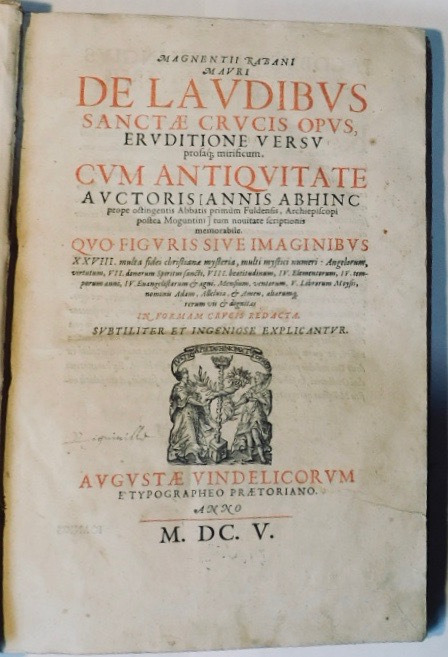
Folio Aa6, Bb4, a-k6, a6, B4, c4. (complete). Printers mark on title page, woodcut initials printed in red, two woodcuts of Alcuin interceding on behalf of Rabanus before Pope Gregory iv, and of Rabanus presenting his poems to the Pope; a figured dedicatory poem to Louis the Pious and a figured prefatory poem, 28 carmina figurata, the first entirely xylographic, the remaining poems combining printed and xylographic letters with the versus intexti printed in red (except fig. xvi), enclosed by either woodcut figures (of the emperor, Christ, the Evangelists, Cherubim, etc.) printed in black or by Christian symbols and characters, most defined by metal rules in red. Bound in contemporary deer skin.
This aside from the prologue this edition is a re-set reproduction of the first printed edition (see above)
#######+++++#######
9) 383J Johannes de Anania
Commentaria super prima et secunda parte libri quinti Decretalium. Add: Repertorium
Bologna : Henricus de Colonia, 7 Dec. 1479, 5 Jan. 1480. $17,000
Large folio 422 x 285mm Pars III (bound first) a8,b6,c10,d6,e8,f4,g8.(lacking a1Blank) Pars I (bound second) a10,b8,i8,k6,l8,m8,n6,o6,p8,q8,r10s 10. Pars II (bound third) A8,-F8,G6,H8,-L8,M6,N8,O8P6,Q8,R8,S6,T8,U10,X8-Z8, &8, ¶8,€8,¡8. In three parts, dated: 7 Dec. 1479 (Commentaria, partes I-II); 5 Jan. 1480 (Repertorium)
No copy of parts II & III in the US. The margin of a2 of the Repertorium cut off with no text loss (see image) This is a very very wide margined copy, with strong and crisp paper. The first leaf is stroked in red and blue. Throughout the rest of the books capital spaces are left blank. This copy is bound in 19th century vellum.
ANANI’A, JOHANNES DE : his family name, Anagni. implies that he was of the family of the Catani, and that his father’s name was Leonardo. He taught canon law in Bologna, and had the reputation of a conscientious man. He studied under Floriano di San Pietro. Alexander Tartagni and Andreas Barbati were his scholars; the former became his step-son, and the latter inherited his library. According to Orlandi, Anania was sent ambassador from the city of Bologna to Pope Martin V. in 1425, and he was also employed to conduct negotiations with other princes. Johannes de Anania at the time of his death, in 1455 or 1458, was archdeacon at Bologna. Spangenberg enumerates four of his works, three of which were published at Lyon between 1521 and 1555 : — 1. A Commentary on the fifth book of the Decretals, published in folio at Lyon in 1521, and reprinted there in 1553. 2. Consilia, discovered and edited by Ludovico Bolognini, in folio, at Lyon in 1555, reprinted at Venice in 1570. 3. “De Revocatione Feudi alienati,” in octavo, at Lyon, in 1546, reprinted at Basle in 1564. 4. A Collection of the Decisions of the Roman Rota, at Venice, in folio, in 1496. Mazzuchelli mentions a treatise on the law as to salaries, “Allegatio de Salario et Stipendio ac de Obligatione et Promissione Domini,” which is preserved in MS. at Bologna in the library of the Collegio di Spagna. In addition to these Lipenius ascribes to Johannes de Anania a legal tract on church patronage, “De Jure Patronatus Ecclesiastico,” published at Amsterdam in 1640; and a collection of cases (” Quaestiones”) at Cologne in 1570. To the folio edition of Baldus, “In Usus Feudorum Commentaria,”
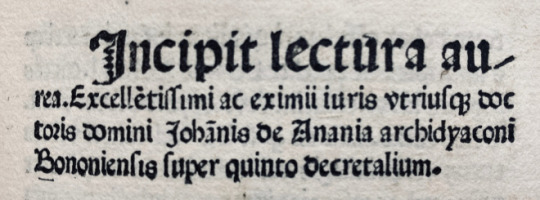
published at Lyon in 1550, there is appended a thesis on the law regarding the alienation of fiefs, maintained by Johannes de Anania at a public disputation in Bologna. The date is not given, but he is styled “Doctor et Canonicus,” and his opponent is said to have been Secundinus de Natis; and the publisher intimates that the MS. had been preserved in the library of Johannes Nevizanus at Asti. No. 446. of the Arundel MSS. in the library of the British Museum contains a treatise “De Usuris” by Johannes de Anania. The volume is of a large folio form, and the ” De Usuris,” written in a small character with numerous contractions, occupies the folios 93. to 164. inclusive, each folio containing four columns. These treatises are the only compositions of the author we have seen, and they leave a favourable impression of his skill in selecting authorities to support and elucidate his positions, and of his talent for lucid arrangement. (Mazzuchelli, Scrittori d’ Italia; Spangenberg, in Ersch und Gruber’s Allgemeine Encyclopadie; Alidosi, Appendice alli Dottori Bolognesi de Legge Canonica e Civile; Orlandi, Notizie degli Scrittori Bolognesi; Baldus Perusinus, in Usus Feudorum Commentaria doctissima, quibus accesserunt Andr. Siculi Adnotationes una cum Joan. de Anania eleganti Disputatione in tres secta Quastiones, Lugduni, 1550, fol.; Arundel MSS. in the British Museum, No. 446.) W. W
Not in Goff: ISTC ij00250150; H 938*; Torchet 521; IGI 5245; IBE 3188; Kotvan 702; Sajó-Soltész 1881; Martín Abad J-44; Voull(B) 2735,20; Walsh 3188; BSB-Ink I-365; GW M12841
Holdings: United States Harvard University, Law School Library (I) only.

)0(
)0(
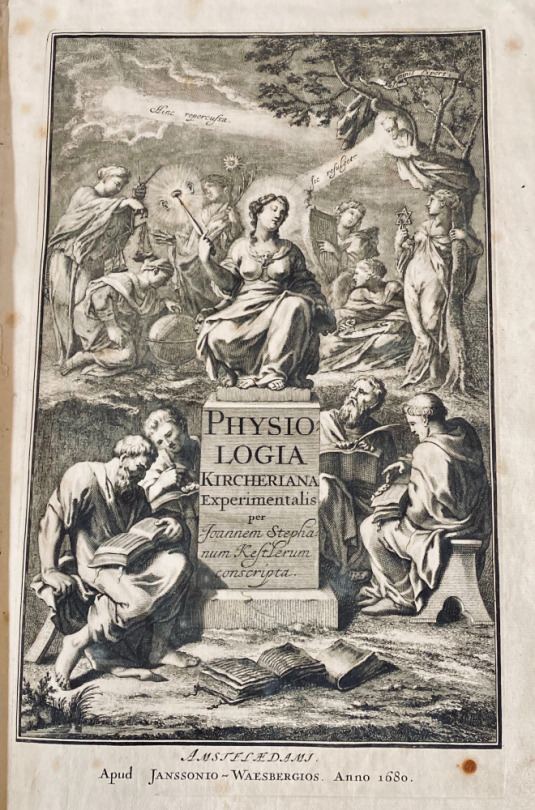
10) 381J Athanasius Kircher 1602-1680
Physiologia Kircheriana Experimentalis, Qua Summa Argumentorum Multitudine & Varietate Naturalium rerum scientia per experimenta Physica, Mathematica, Medica, Chymica, Musica, Magnetica, Mechanica comprobatur atque stabilitur. Quam Ex Vastis Operibus Adm. Revdi. P. Athanasii Kircheri extraxit, & in hunc ordinem per classes redegit Romæ, Anno M. DC. LXXV. Joannes Stephanus Kestlerus Alsata, Authoris discipulus, & in re litterariâ assecla, & coadjutor.
Amsterdam: Ex Officinâ Janssonio-Waesbergiana. Anno 1680 $9,500
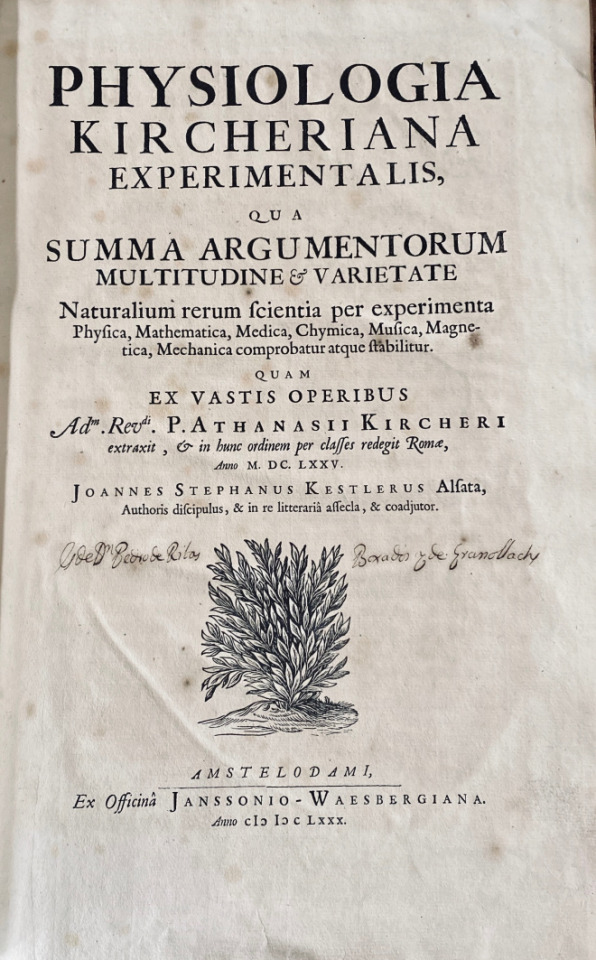
Folio. 15 x 9 3/4 inches. *4, A-Z4, Aa-Ii4. First edition.mmThis copy is quite clean and crisp throughout, never having been washed or pressed. There is some occasional spotting and browning. but none is too extensive. The binding is twentyth century full vellum with title on spine. an impressive and large copy!
“Thus in the must varied branches of science Kircher played the role of pioneer. Even medicine received his attention, as is shown for example by his treatise, ‘Scrutinium phyisco-medicum contagiosæ luis, quæ pestis dicitur’ (Rome, 1663). His scientific activities brought him into scientific correspondence with scholars laboring in the most different fields, as the numerous volumes of his extant letters show. It is to his inventive mind that we owe one of the earliest of our counting machines: the speaking-tube and æolian harp were perfected by him. He was also the inventor of the magic lantern which has since been brought to such perfection and is and is today almost indispensable. [All of these devices are illustrated in the present work, compiled in the year of the author’s death by Kircher and his student Johann Stephan Kestler, including three large and striking engravings of magic lanterns.]” May I ask the reader to take the following quote with a measure of indulgence for its closed minded author [circa 1913] with the hope that modern folk of the last decade of the second millennium have a bit more tolerance for the many sciences that we have yet to master. “That the most varied judgments should be formed and expressed on a man of such encyclopædic knowledge was only to be expected. He tried to find a grain of truth even in the false sciences of alchemy, astrology, and horoscopy, which were still in his time much in vogue, nor is it surprising that in the province of astronomy he did not at this early date defend the Copernican System.” (the above two quoted taken from the Catholic Encyclopedia, vol. viii, page 662) Kircher was an accomplished and versatile scholar who applied his intellectual abilities to a myriad of scientific problems. This work is a fascinating compendium of scientific experiments and principles which documents the accomplishments of early modern thinkers of the west.
^)^)^)^(^(^(^
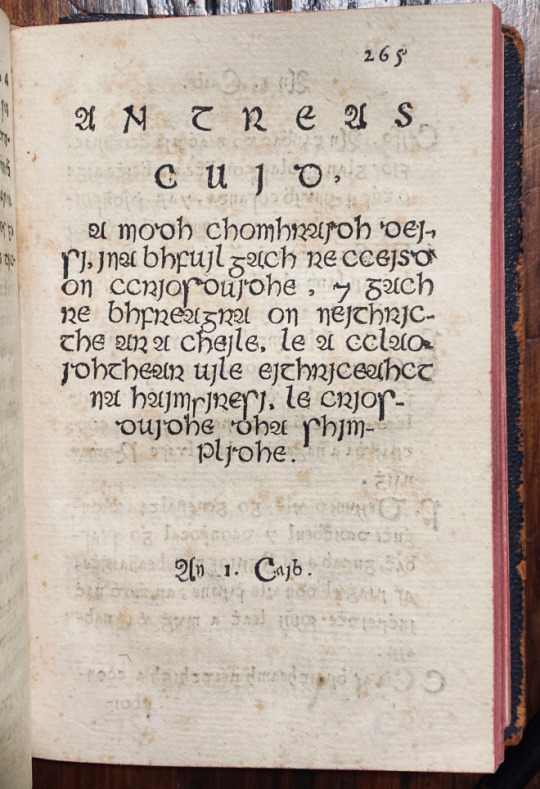
11) 380J Francis Molloy. fl 1660
Lucerna fidelium, seu, Fasciculus decerptus ab authoribus magis versatis, qui tractarunt de doctrina Christiana : divisus in tres partes.
Romæ : Typis Sacræ Congreg. de Propaganda Fide, M DC LXXVI [1676] $4,500 Octavo 6 X 4 inches : A-2B8 2C2. complet, signature ) is mis-signed . This copy is bound in early 20th century sheep.
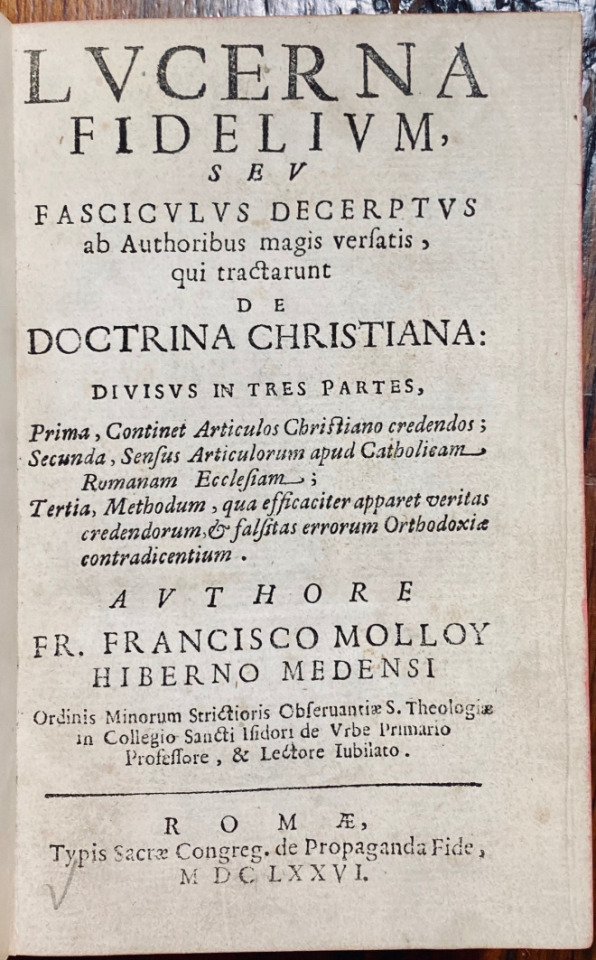
MOLLOY or O’MAOLMHUAIDH, FRANCIS (Jl. 1660), theologian and grammarian, was a native of the county of Meath, Ireland. The family of which he was a member had extensive landed possessions in the district known as O’Molloys’ Country, and some of them engaged actively in the Irish movements from 1641 to 1652.
Francis Molloy entered the order of St. Francis, became a priest, was appointed professor of theology at St. Isidore’s College, Rome, and acted as agent for the Irish catholics at the papal court in the reign of Charles II. His first published work was entitled ‘Tractatus de Incarnatione ad mentern Scoti,’ 1645. This was followed in 1658 by ‘ Jubilatia genethliaca
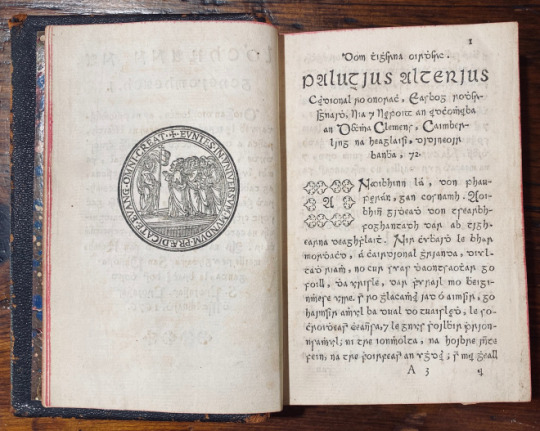
in honorem Prosperi Balthasaris Philippi, Hispani principis, carmine,’ and by a Latin treatise on theology in 1666.
A catechism of the doctrines of the catholic church in the Irish language was published by Molloy in 1676 with the title: ‘Lucerna tidelium, seu fasciculus decerptus ab authoribus magis versatis qui tractarunt de doctrina Christiana.’ It was printed at Rome at the press of the Congregation ‘de propaganda fide,’ ( This book is the first book they printed in Irish Type) from which, in 1677, issued another book by Molloy, entitled ‘Grammatica Latino-Hibernica,’ 12mo, the first printed grammar of the Irish language. Edward Lhuyd [q. v.], in his’ Archaeologia Britannica,’published at Oxford in 1707, mentioned that he had seen a manuscript grammar of the Irish language copied at Louvain in 1669 which partially corresponded with that of Molloy. He added that Molloy’s grammar, although the most complete exta’nt in his time, was deficient as to syntax and the variation of the nouns and verbs. The date of Molloy’s death has not been ascertained. In 1626 Propaganda Fide had installed a printing press for the foreign missions and not much later another one was brought to Louvain where books and catechisms were printed for both the local college and the Irish mission.* The problem with the Propaganda printing press was that only books in Latin and Italian were allowed to be printed so it took until 1674 when Francis Molloy asked for permission to print a catechism there in Irish with the explanation “che altra malamente capisce e vacilla assai per mancanza d’intruttore e d’intruttion sana.”**.
[“Irish priests at Rome had a new Irish type cut about 1675 … [this was] their first book.”- -H. Reichner, Catalogue 34, Jan. 1968]
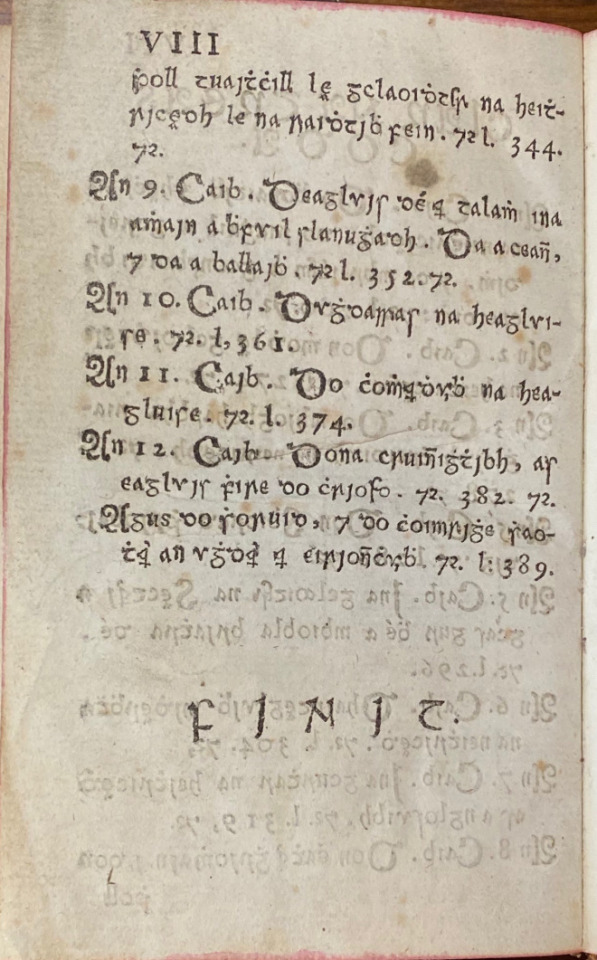
Wing O291C, English short title catalogue,; R41480; Clancy, T.H. English Catholic books, 1641-1700 (rev. ed.),; entry 743; Catalogue of seventeenth century Italian books in the British Library,; page 628 *& ** ;Egan, Bartholomew (ed.): Notes on Propaganda Fide Printing Press and Correspondence concerning Francis Molloy O.F.M., in: Collectanea Hibernica, No. 2 (1959), pp. 115-124.
)0(
)0()0(
With a reference to the invention of printing on the verso of Folio 64.
12) 359J Werner Rolewinck 1425-1502
Fasciculus temporu[m] omnes antiquo[rum] chronicas strictim complectens felici numine incipit. Prologus.
Venice : Erhard Ratdolt, 8 Sept. 1485 $16,000
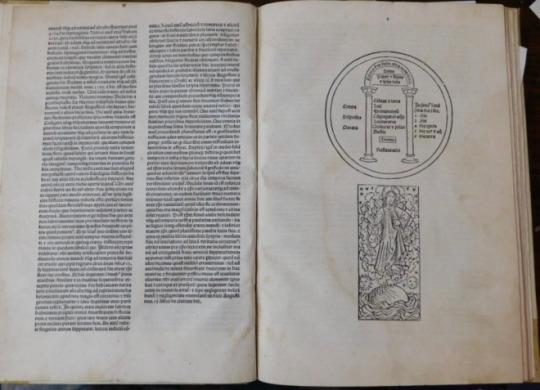
Folio (275 x 195 mm). [A]8 [a-g]8 [h]10 75 leaves without signatures or page numbers (9 leaves, 1-66 foliated ), 3 columns in table, 59 lines and foliation, gothic letter, 2 large ornamental initials, 59 woodcuts, one full-page, woodcut diagram. Fifth and last Venetian edition, and fourth Ratdolt edition being the most complete edition of Rolewinck s chronological history of the world. The chronology follows a double time-line, measuring time from both the Creation and the birth of Christ to the death of the Ottoman Sultan Mehmed II commonly known as Mehmed the Conqueror in the year 1481, demanding a
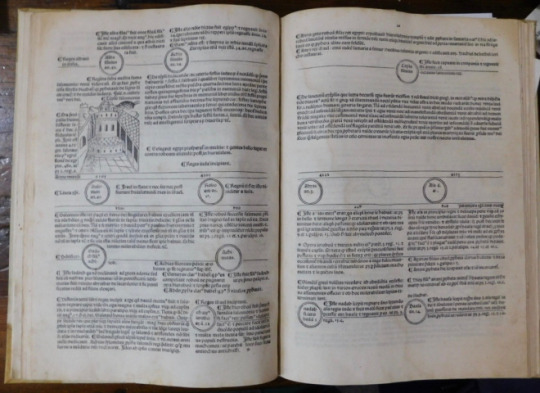
remarkably complex typographical layout. The Fasciculus Temporum (Little bundles of time) was the first book printed on history of the world, it is also one of the earliest and greatest of illustrated incunabula. The illustrations show Noah s Ark, the tower of Babel and contain many town views including Jerusalem, Syracuse, Rome and the Doge s Palace in Venice.
Rolewinck (1425-1502) was a Carthusian monk and prolific author. This book was both the most popular of his numerous writings and the most popular concise world chronicle of its time, being printed 32 times in the 15th century, including translations into French, German and Dutch . Rolewinck’s Fasciculus Temporum was an enormously popular world chronicle, appearing in over 30 incunabular editions in Latin, German, French, and Dutch. A very handsome and typographically-sophisticated volume, with varying columns, circular devices with inset type, and woodcuts throughout.
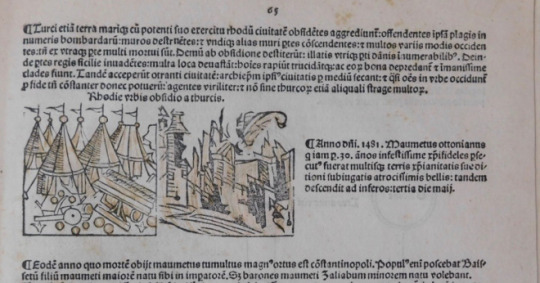
This work aspires to trace the history of the world from the beginning of time until the year of pulication. The thirty-three woodcuts are crisp and rather charming, and, like those in many fifteenth- and sixteenth-century chronicles, are occasionally reused to illustrate different events and locations. The work is fascinating for the comprehensiveness of its content as well as the beauty of its execution. Of particular interest is a reference to the invention of printing (in 1454) on the verso of Folio 64.
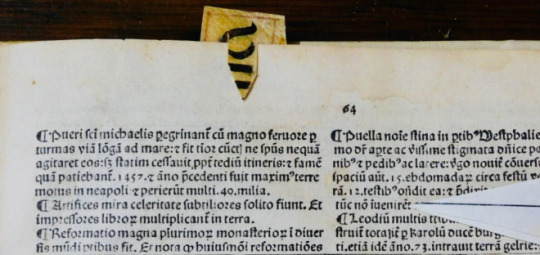
Goff R271; GW M38738; ; BMC V 290; H 6935*; Redgr 52; Essling 280; Sander 6530; Schr 5116C; Pell Ms 10192 (9969); CIBN R-177; Arnoult 1276; Neveu 528; Nice 269; Torchet 821; Polain(B) 4691; IDL 3943; IBE 4955; IGI 8420; CCIR R-40; Kotvan 1024; Sajó-Soltész 2972; Gspan-Badalić 590; IBPort 1576; Mendes 1124, 1125, 1126; Madsen 3526; Martín Abad R-48; Voull(B) 3801; Hubay(Augsburg) 1811; Hubay(Eichstätt) 898; Walsh 1830; Rhodes(Oxford Colleges) 1525; Bod-inc R-121; Sheppard 3688; Pr 4404; BSB-Ink R-247
#######+++++#######
13) 367J Petrus de Rosenheim. (1380-1432). Nom probable : Petrus Wiechs
[Roseum memoriale divinorum eloquiorum]
[Köln] : [Southern Germany : n.pr., about 1480-90?] or [Cologne? : n.pr., about 1483] or [Ludwig von Renchen?], 1483. $12,000
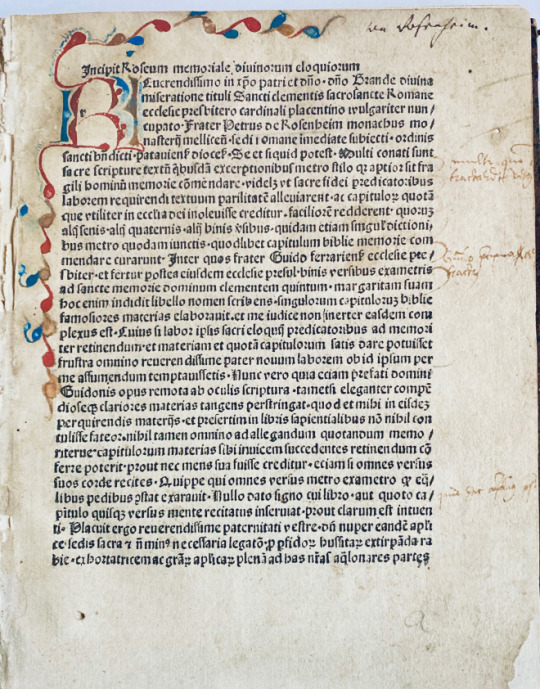
Quarto (190 x 155 mm). Collation: a-f8 [1-68]. [48] leaves. First Edition. Text in one column, 32 lines. Type: 80G. Initials painted in red, and blue ink throughout. Simple vellum binding from a 15th century vellum leaf. Gothic script. . A very good copy, old repair to the first blank leaf, a few spots, pale stain at the lower blank corner of the first quires. It is not known where and by which press this edition was printed. ISTC gives Southern Germany and a date of c.1480-1490, GW tentatively suggests Oberrhein, 1483, and Proctor attributes it to Ludwig Von Renchen in Cologne. The hexameters of each section of the summary form an acrostic of the letters of the alphabet. (alphabetarium) as to insure memorization in the proper sequence, the first word of each verse falls neatly into alphabetical order. [1,194 short mnemonic verses] It uses characteristic couplets (distiches) to express the main content of all chapters of the Old and New Testament. This introduction makes it possible to easily find every quote in the Bible.
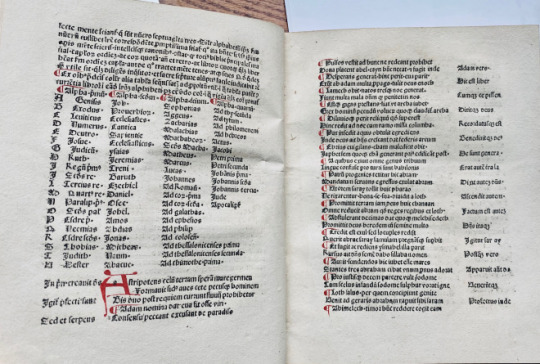
A significant record of the essential role of memory in late-medieval piety, One of the earliest printed books on the ars memorativa or mnemotechnic was composed by the German Benedictine monk Petrus of Rosenhaym (Upper Bavaria), written between 1423 and 1426 for Cardinal Giulio Branda di Castiglione. Petrus of Rosenhaym composed numerous treatises, sermons, and verses: the Roseum memoriale is surely his most famous work, enjoying wide popularity during the fifteenth century and first half of the sixteenth century. The mnemotechnic method here employed is extremely complex: the hexameters of each section of the summary form an acrostic of the letters of the alphabet. in. A highly popular and broadly used manual, its copies could be found in almost every European church after the invention of the printing press it was printed in several different locations. This early medieval incunable has not been clearly dated| researchers attribute it to the Upper Rhine region sometime between 1480 and 1483. After studying at the University of Vienna, Petrus de Rosenhaym, along with his friend Nikolaus Seyringer, moved to Subiaco, where he entered the Benedectine order. In 1413, he was appointed prior to the cloister of Rocca di Mondragone near Capua. In 1416, he took part in the Council of Konstanz, and later he was prior in Melk (Lower Austria). After 1423, he was appointed ‘cursor biblicus’ and ‘magister studentium’. Goff R336; BMC I 312; ; GW M32724; ISTC; ir00336000; Polain(B) 3128; IBE 4559; IGI 7668; IBP 4380; Sajó-Soltész 2676; Madsen 3549; Borm 2134; Hubay(Würzburg) 1704; AmBCat 199; Walsh 492; Oates 867; Pr 1517;; BSB P-362; Van der Haegen II,2:16,4?; Young 278;.
Copies in the United States of America: Brown, Harvard, Library of Congress, Huntington, The Newberry Library, Yale
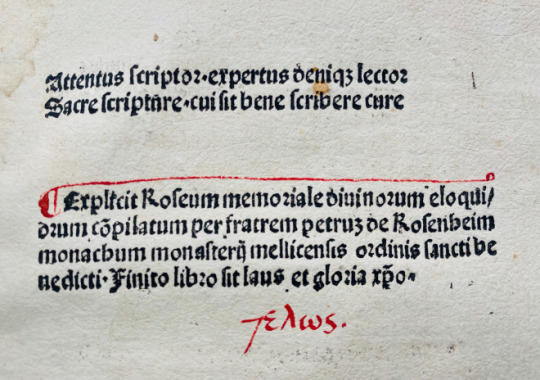
^)^)^)^(^(^(^
^)^)^)^(^(^(^
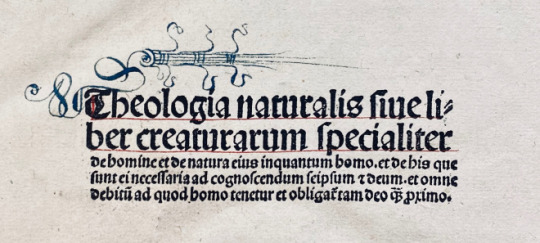
14) 384J Raymundus de Sabunde -1436
Theologia naturalis, sive, Liber creaturarum : specialiter de homine et de natura eius inquantum homo, et de his que sunt ei necessaria ad cognoscendum seipsum [et] deum et omne debitu[m] ad quod homo tenetur et obligat[ur] tam deo quam p[ro]ximo.
Straßburg: Martin Flach, 21 January 1496. $17,000
Imp[re]ssus Argentine per Martinum Flach inibi co[n]ciuem anno incarnat[i]o[n]is d[omi]nice Millesimoq[ua]dringentesimononagesimosexto men[sis] v[er]o Ianuarij die vicesimop[ri]mo
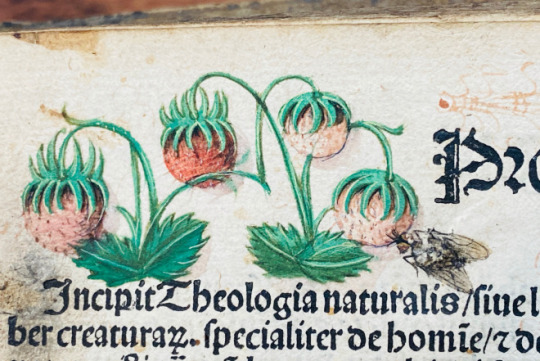
Folio (280 x 200mm.) π6 a8 b-y6 z8 [et]6 [con]8 (the last leaf supplied from another copy, printed on recto only), The second leaf (π2) has a beautiful a green painted initial A [Amor] on a gold ground with pink and blue edges, extending into the margins with green-stemmed pink and gold flowers on opposite side. The first leaf of the text proper (a1) Has a large blue painted initial A on a gold ground with pink and green edges, large pink and purple flowers, strawberries thistles and a Tromp l’oeil of a Dead fly,( quite charming) fill uppermargin; 3-line initials in alternating red and blue, rubricated throughout. This is the first dated edition.
It is bound in Contemporary deerskin over wooden boards, covers panelled and tooled in blind with repeated small rosette tool, remains of paper labels on spine (lacking metal furniture and clasps, some wear and small areas of loss). This copy has some contemporary manuscript notes, including a two-line note on f. b2recto, and on f.a2verso is a marginal drawing of the scala naturae with the four gradus marked. Provenance: Contemporary inscription of Johannes Pengl (Penngl) from Weißenburg in Bavaria, who was active in Eichstätt & Vienna, with a note of cost of binding on final paste down. Later notes and shelf-mark on front paste-down and loose sheet.
Colophon: Finit liber creatura[rum] seu nature siue nature siue de ho[m]i[n]e p[ro]pt[er] que[m] alie creature facte su[n]t ex cui[us] cognit[i]one illu[m]inat[ur] ho[mo] i[n] [co]gnit[i]o[n]e dei [et] creaturarum.
This text marks the dawn of a knowledge based on Scripture and REASON.
The Catholic Encyclopedia sees this as “It represents a phase of decadent Scholasticism, and is a defense of a point of view which is subversive of the fundamental principle of the Scholastic method. The Schoolmen of the thirteenth century, while holding that there can be no contradiction between theology and philosophy, maintain that the two sciences are distinct. Raymond breaks down the distinction by teaching a kind of theosophy, the doctrine, namely that, as man is a connecting link between the natural and the supernatural, it is possible by a study of human nature to arrive at a knowledge even of the most profound mysteries of Faith. The tendency of his thought is similar to that of the rationalistic theosophy of Raymond Lully….Moreover, in Spain scholastics, in combating Islam, borrowed the weapons of their erudite antagonists. Close internal resemblance indicates that Raimund de Sabunde was preceded in method and object by Raymund Lully.” CE

What is new and epoch-making is not the material but the method; not of circumscribing religion within the limits of reason, but, by logical collation, of elevating the same upon the basis of natural truth to a science accessible and convincing to all. He recognizes two sources of (1)knowledge, the book of nature and (2) the Bible. The first is universal and direct, the other serves partly to instruct man the better to understand nature, and partly to reveal new truths, not accessible to the natural understanding, but once revealed by God made apprehensible by natural reason. The book of nature, the contents of which are manifested through sense experience and self-consciousness, can no more be falsified than the Bible and may serve as an exhaustive source of knowledge; but through the fall of man it was rendered obscure, so that it became incapable of guiding to the real wisdom of salvation. However, the Bible as well as illumination from above, not in conflict with nature, enables one to reach the correct explanation and application of natural things and self. Hence, his book of nature as a human supplement to the divine Word is to be the basic knowledge of man, because it subtends the doctrines of Scripture with the immovable foundations of self-knowledge, and therefore plants the revealed truths upon the rational ground of universal human perception, internal and external.
The first part presents analytically the facts of nature in ascending scale to man, the

climax; the second, the harmonization of these with Christian doctrine and their fulfillment in the same. Nature in its. four stages of mere being, mere life, sensible consciousness, and self-consciousness, is crowned by man, who is not only the microcosm but the image of God. Nature points toward a supernatural creator possessing in himself in perfection all properties of the things created out of nothing (the cornerstone of natural theology ever after). Foremost is the ontological argument of Ansehn, followed by the physico-theological, psychological, and moral. He demonstrates the Trinity by analogy from rational grounds, and finally ascribes to man in view of his conscious elevation over things a spontaneous gratitude to God. Love is transformed into the object of its affection; and love to God brings man, and with him the universe estranged by sin, into harmony and unity with him. In this he betrays his mystical antecedents. Proceeding in the second part from this general postulation to its results for positive Christianity, he finds justified by reason all the historic facts of revealed religion, such as the person and works of Christ, as well as the infallibility of the Church and the Scriptures; and the necessity by rational proof of all the sacraments and practices of the Church and of the pope. It should be added that Raimund’s analysis of nature and self-knowledge is not thoroughgoing and his application is far from consistent. He does not transplant himself to the standpoint of the unbeliever, but rather executes an apology on the part of a consciousness already Christian, thus assuming conclusions in advance that should grow only out of his premises. Yet his is a long step from the barren speculation of scholasticism, and marks the dawn of a knowledge based on Scripture and reason.
In its day, and for a long time later, it was a celebrated text. The title translates ‘Natural Theology or the book of [living] creatures, in particular about man and his nature inso far as he is man, and about those things necessary for him to know both himself and God, and about every duty by which man is held and obligated both in respect of God and his neighbour.’ The scope is therefore pretty wide. The main point of Sebond’s work is that that faith can be taught, attained, understood by natural reason and not simply on the basis of blind faith and literal adherence to Scripture, although this last is given full weight as is the teaching of ‘sacrosancta romana ecclesia who is the mother of all faithful christians, mistress of grace and faith and rule of truth…’ (preface on a2ra). The work is divided into 330 ‘tituli’ or chapters beginning with the origins of natural theology and ending with the last judgement, the subjects treated at greatest length being ‘God’ and ‘Man’.
Theologia Naturalis, which circulated widely in manuscript and is known particularly in a manuscript in Toulouse (747) corrected after the author’s own copy, was first published in what is called the ‘third family’ in Deventer in 1484-85 (possibly through the offices of the Brothers of the Common Life; the Bodleian copy is from their house at Doesburg, Holland), and then Lyon ca. 1488 from the printer Balsarin. This Flach printing circulated widely (a copy was at Winchcomb abbey in Gloucestershire within a few years (now in Glasgow) and early in the 16the century Archbishop Warham (Abp. 1503-32 ) gave a copy to All Souls College, Oxford) and is the first dated edition. There were a number of later editions (including another Flach edition of 1501) right up into the 17th century. Indeed the well-known 17th-century philosopher Kenelm Digby ( 1603-1664) had a copy of this edition (now at Durham University Library at Bamburgh Castle). Part of the Theologia (Dialogos de la naturaleza delhombre) was translated into Spanish and printed in Madrid in 1610 and 1616, and a resumé by the Carthusian Petrus Dorlandus (Viola anime per modum dyalogi) was published in Cologne in 1499 (ISTC id00360000 ) and in Toulouse in 1500 I(ISTC id003610000).. The Theologia because of the importance it accorded human reason did not escape the notice of the holy Office and was placed on the Index in the middle of the 16th century. Montaigne indeed discovered this during his visit to Rome.
Goff R33.; BMC I, 154.; HC 14069*; GW M36911; Bod-inc R-018. ISTC ir00033000. Palau 283900
◊
◊ ◊
◊
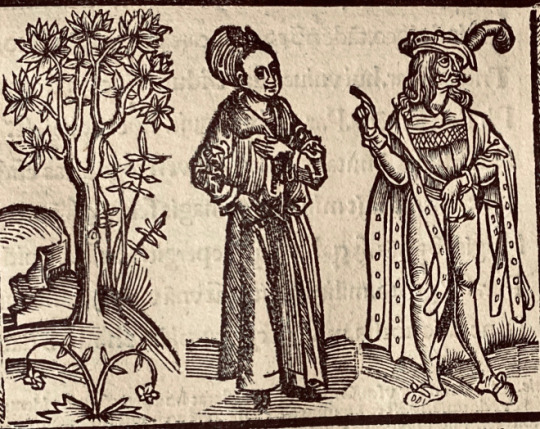
15) 369J Publius Terentius Afer. 185-
Terentius Comico Carmine
Impressum in nobili Helvecior[um] urbe Arge[n]tina : Per Ioanne[m] Grüninger mira etium arte ac diligentia. 1503 $7,500
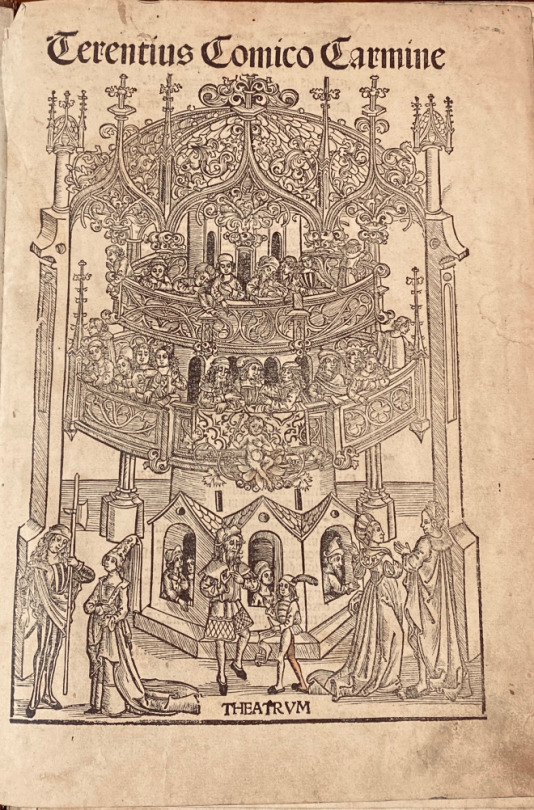
Folio A6 B8 C-Z6 AA6 Bb4 Cc6. There are numerous handwritten annotations in ink (marginal and interlinear, ff. IX-XIX). The binding of half-calf with corners of the XIXth, back with 4 sewing support with pieces of title of red and green leather, boards covered with stony marbled paper. { A typical Kloss binding} (there is a tear sig. B1, with loss; first signature cut shorter at the lower margin; restorations of paper with the last sheets in the upper margin; Yet this copy remains a beautiful illustrated edition of the comedies of Terence with comments by Aelius Donatus and Calphurnius. From the presses of the famous and prolific Strasbourg printer-publisher Johann Reinhard, known as Grüninger, it is remarkably illustrated with 7 large full-page woods (including the famous representation of a theater on the title),

woodcuts depicting the dramatis personae in a land- or cityscape, one at the beginning of each play, and 142 woods in the text 19 of the cuts appear here for the first time; the others are from the 1496 ed. «Grüninger’s illustrations, intended to clarify the complexities of Terence’s plots for the reader, act as visual mnemonic devices for the book’s anticipated student audience. This is demonstrated especially in the full-page woodcut that begins each play, where all of the characters are displayed with connecting lines to indicate their interrelationships. covered with stony marbled paper. { A typical Kloss binding} (there is a tear sig. B1, with loss; first signature cut shorter at the lower margin; restorations of paper with the last sheets in the upper margin; Yet this copy remains a beautiful illustrated edition of the comedies of Terence with comments by Aelius Donatus and Calphurnius. From the presses of the famous and prolific Strasbourg printer-publisher Johann Reinhard, known as Grüninger, it is remarkably illustrated with 7 large full-page woods (including the famous representation of a theater on the title), woodcuts depicting the dramatis personae in a land- or cityscape, one at the beginning of each play, and 142 woods in the text 19 of the cuts appear here for the first time; the others are from the 1496 ed.

«Grüninger’s illustrations, intended to clarify the complexities of Terence’s plots for the reader, act as visual mnemonic devices for the book’s anticipated student audience. This is demonstrated especially in the full-page woodcut that begins each play, where all of the characters are displayed with connecting lines to indicate their interrelationships. A verbal explanation and plot summary accompanies each of these illustrations. The most remarkable feature of Grüninger’s Terence is his use of small interchangeable woodcuts that were combined to create the individual scene illustrations for each play. Individual blocks were cut for most of the characters of the six plays, who are identified by name in overhead banners. The blocks were cleverly combined repeatedly in groups of two to five, sometimes together with cuts of trees and buildings, to create the illustrations. Grüninger was attempting to use the woodcuts as repeatable and combinable objects, much in the same manner as movable type» (Christine Ruggere, in Vision of a Collector: The Lessing J. Rosenwald Collection in the Library of Congress)
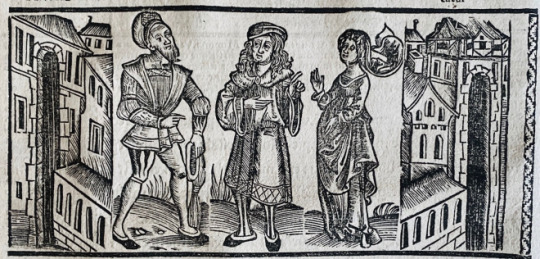
Terence writes in a simple conversational Latin, pleasant and direct. Due to his clear and entertaining language, Terence’s works were heavily used by monasteries and convents during the Middle Ages and The Renaissance. Scribes often learned Latin through the meticulous copying of Terence’s texts. Priests and nuns often learned to speak Latin through reenactment of Terence’s plays, thereby learning both Latin and Gregorian chants. Although Terence’s plays often dealt with pagan material, the quality of his language promoted the copying and preserving of his text by the church. The preservation of Terence through the church enabled his work to influence much of later Western drama. [Holloway, Julia Bolton (1993). Sweet New Style: Brunetto Latino, Dante Alighieri, Geoffrey Chaucer, Essays, 1981-2005.] This copy has the book plate and a binding typical for Kloss. It is NOT Melanchthon’s copy, or his notes!
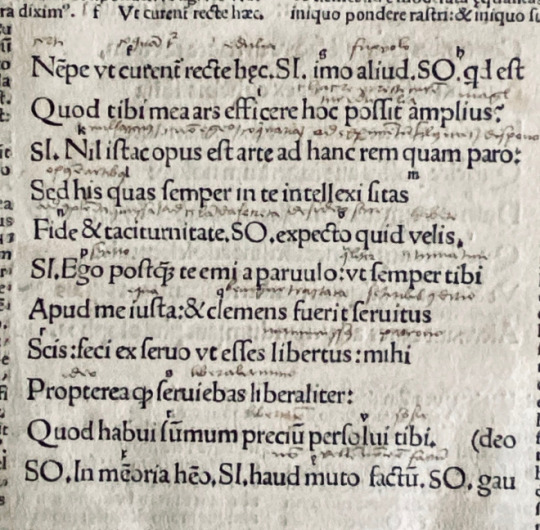
Georg Franz Burkhard Kloss (31 July 1787 Frankfurt am Main – 10 February 1854 Frankfurt). Kloss was the son of a physician and studied medicine at Heidelberg and Göttingen, where he became one of the cofounders of the Corps Hannovera Göttingen. He practiced medicine in Frankfurt. He became a book collector, and gathered a fine collection of old manuscripts,. On February 21, 1838, New York book auction house Cooley & Bangs began a three day sale during which they offered more than 313 incunabula distributed among 1,302 lots. Many incunables came from the collection of George Kloss and had appeared in the London sale of his books three years before. It is entirely possible that the 1838 sale was the first time in America that so many incunables were offered all at once in a single auction..
The bulk of the Kloss books were sold by Sotheby in 1835. Most of the books containing notes were attributed as owned and annotated by Melanchthon .
Catalogue of the library of Dr. Kloss of Franckfort a. M. including many original and unpublished manuscripts, and printed books with ms. annotations, by Philip Melancthon …Which will be sold by auction, by Mr. Sotheby and son … May 7th, and nineteen following days (Sundays excepted) .
https://babel.hathitrust.org/cgi/pt?id=hvd.32044055066971&view=1up&seq=9
Adams D 304. Proctor 9889. Ritter 2284.
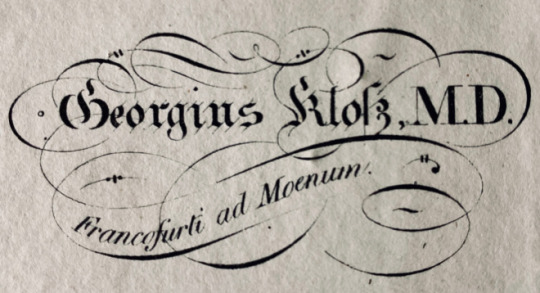


Fascicule XXI. Media Plaga 3-4/2020 Only a day or two ago I was notified that I was in contact with some people tested for and found positive for Covid-19, this came as nothing un expected, I was in contact with hundreds of people many from Europe recently.
#early printed books#fascicule XXI#George Kloss#illustrated incunabulum#Incunabula#Irish authors#irish/gaelic printing#Kircher#Not in Goff#rare book catalogue
9 notes
·
View notes